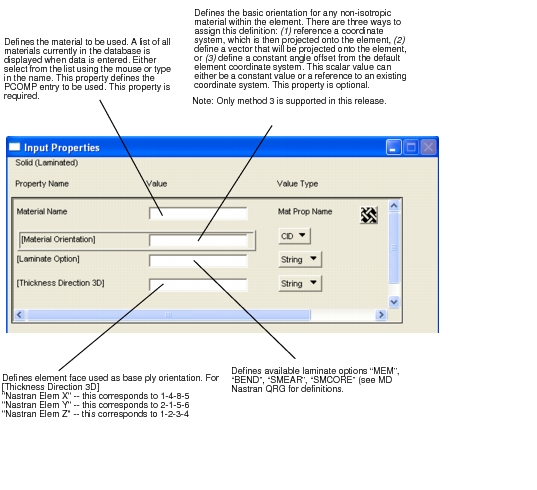

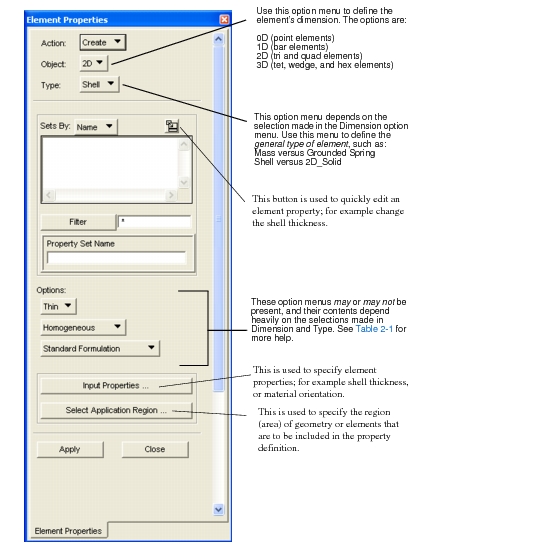
Dimension | Type | Option 1 | Option 2 |
0D | • Mass | • Coupled • Grounded • Lumped | |
1D | • Beam | • Standard • P-Formulation | |
• Standard • P-element | |||
• Rod | • Standard • CONROD | ||
• Spring | |||
• Damper | • Scalar • Viscous | ||
• Gap | • Adaptive • Non-Adaptive | ||
• 1D Mass | |||
• PLOTEL | |||
• Bush | |||
• Spot Weld Connector | |||
• Fastener Connector | |||
2D | • Shell | • Homogeneous | • Standard • Revised • P-element |
• Laminate | • Standard • Revised | ||
• Equivalent Section | • Standard • Revised • P-element | ||
• Bending Panel | • Standard • Revised • P-element | ||
• 2D-Solid | • Plane Strain | • Standard • Revised | |
• Plane Stress | |||
• Axisymmetric | • Standard • Hyperelastic Formulation • PLPLANE | ||
• Membrane | • Standard • Revised • P-Formulation | ||
3D | • Solid | • Homogeneous | • Standard • P-Formulation • Hyperelastic Formulation • Solid Shell |
• Laminate • Gasket | |||
Action | Dimension | Type | Option(s) | Topologies |
Create | 0D | Mass | Coupled | Point/1 |
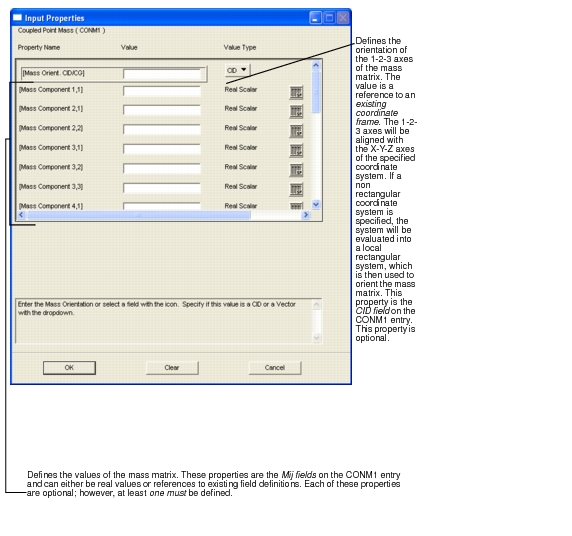
Prop Name | Description |
Mass Component 3,3 Mass Component 4,1 Mass Component 4,2 Mass Component 4,4 Mass Component 5,1 Mass Component 5,2 Mass Component 5,3 Mass Component 5,4 Mass Component 5,5 Mass Component 6,1 Mass Component 6,2 Mass Component 6,3 Mass Component 6,4 Mass Component 6,5 Mass Component 6,6 | Defines the values of the mass matrix. These are the Mij fields on the CONM1 entry. These properties can either be real values or references to existing field definitions. Each of these properties are optional; however, at least one must be defined. |
Action | Dimension | Type | Option(s) | Topologies |
Create | 0D | Mass | Grounded | Point/1 |
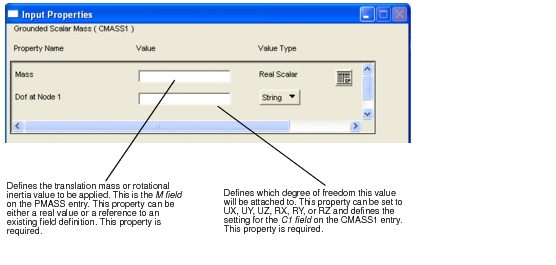
Action | Dimension | Type | Option(s) | Topologies |
Create | 0D | Mass | Lumped | Point/1 |
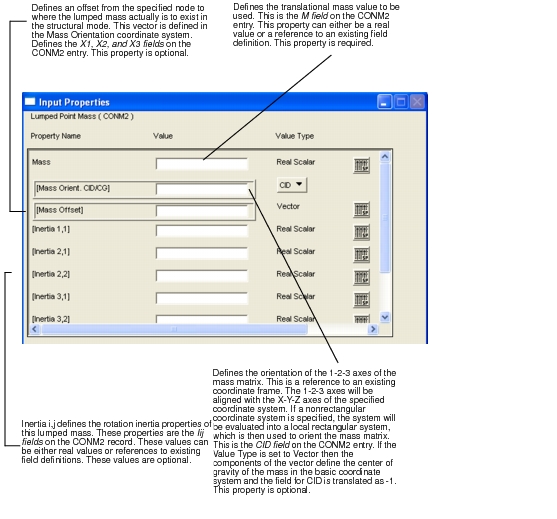
Prop Name | Description |
Inertia 3,1 Inertia 3,2 Inertia 3,3 | Inertia i,j defines the rotation inertia properties of this lumped mass. These are the Iij fields on the CONM2 entry. These values can be either real values or references to existing field definitions. These values are optional. |
Action | Dimension | Type | Option(s) | Topologies |
Create | 0D | Grounded Spring | Point/1 |
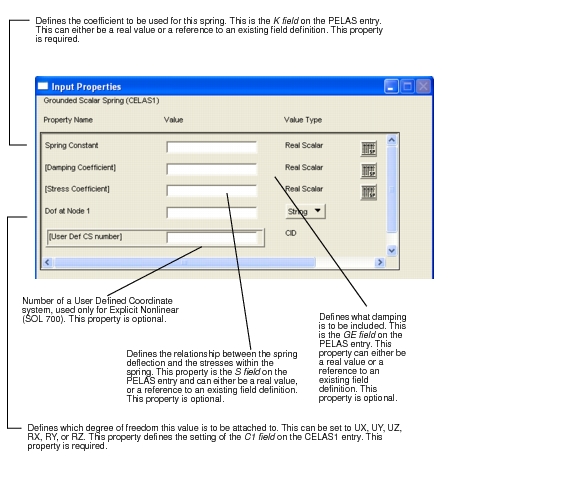
Action | Dimension | Type | Option(s) | Topologies |
Create | 0D | Grounded Damper | Point/1 |
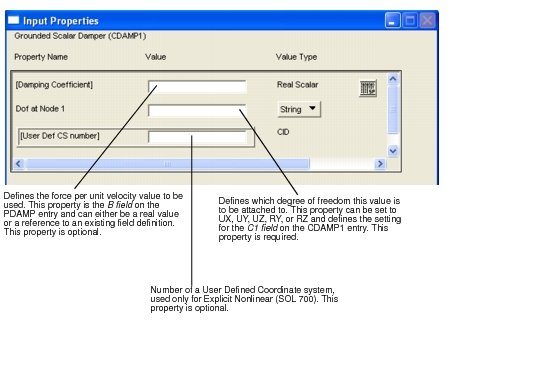
Action | Dimension | Type | Option(s) | Topologies |
Create | 1D | Bush | Bar/2 |
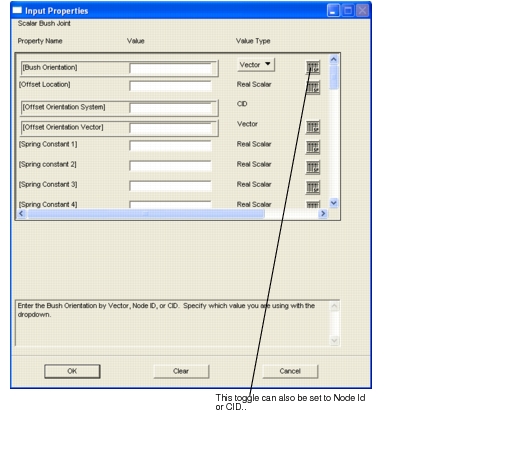
Prop Name | Description |
Bush Orientation System | CID specifies the Grounded Bush Orientation System. The element X,Y, and Z axes are aligned with the coordinate system principal axes. If the CID is for a cylindrical or spherical coordinate system, the grid point specified locates the system. If CID = 0, the basic coordinate system is used. |
Spring Constant 1 Spring Constant 2 Spring Constant 3 Spring Constant 4 Spring Constant 5 Spring Constant 6 Stiff. Freq Depend 1 Stiff. Freq Depend 2 Stiff. Freq Depend 3 Stiff. Freq Depend 4 Stiff. Freq Depend 5 Stiff. Freq Depend 6 | Defines the stiffness associated with a particular degree of freedom. This property is defined in terms of force per unit displacement and can be either a real value or a reference to an existing field definition for defining stiffness vs. frequency. |
Stiff. Force/Disp 1 Stiff. Force/Disp 2 Stiff. Force/Disp 3 Stiff. Force/Disp 4 Stiff. Force/Disp 5 Stiff. Force/Disp 6 | Defines the nonlinear force/displacement curves for each degree of freedom of the spring-damper system. |
Damping Coefficient 1 Damping Coefficient 2 Damping Coefficient 3 Damping Coefficient 4 Damping Coefficient 5 Damping Coefficient 6 Damp. Freq Depend 1 Damp. Freq Depend 2 Damp. Freq Depend 3 Damp. Freq Depend 4 Damp. Freq Depend 5 Damp. Freq Depend 6 | Defines the force per velocity damping value for each degree of freedom. This property can be either a real value or a reference to an existing field definition for defining damping vs. frequency |
Structural Damping Struc. Damp Freq Depend | Defines the non-dimensional structural damping coefficient (GE1). This property can be either a real value, or a reference to an existing field definition for defining damping vs. frequency. |
Stress Recovery Translation Stress Recovery Rotation | Stress recovery coefficients. The element stress are computed by multiplying the stress coefficients with the recovered element forces. |
Strain Recovery Translation Strain Recovery Rotation | Strain Recovery Coefficients. The element strains are computed by multiplying the strain coefficients with the recovered element strains. |
Action | Dimension | Type | Option(s) | Topologies |
Create | 1D | Beam | General Section | Bar/2 |
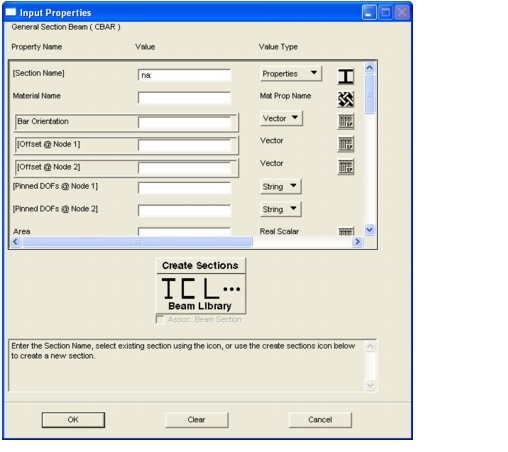
Note: | CBAR entries will include all user input pin flags. |
Section Name | Specifies a beam section previously created using the beam library |
• Value Type | Allows you to define a bar/beam section either by Dimensions (PBARL/PBEAML) or by Properties (PBAR/PBEAM). If Dimensions is choosen, the MD Nastran’s built-in section library (Version 69 and later), PBARL/PBEAML, (for the standard Beam Library) or PBRSECT/PBMSECT (for an Arbitrary section) will be used to define the bar/beam. If Properties is chosen, the standard bar/beam properties, PBAR/PBEAM will be used to define the beam section. If the Dimensions Option is set to Dimensions, the Translation Parameters Version must be set to version 69 or later. |
Material Name | Defines the material to be used. A list of all materials currently in the database is displayed when data is entered. Either select from the list using the mouse, or type in the name. This property defines the value to be used in the MID field on the PBAR entry. This property is required. |
Bar Orientation | Defines the local element coordinate system to be used for any cross-sectional properties. This orientation will define the local XY plane, where the x-axis is along the beam. This orientation defines the value for the X1, X2, X3, or G0 fields on the CBAR entry. This property is required. |
• Value Type | Specifies how the bar orientation is defined: Vector – Specified using a vector Node Id – Specified using an existing node in the beam XY plane When the value type is Vector, it is always input in either the Patran global or some other Patran user defined coordinate system (i.e. <0 1 0 Coord 5>). |
• Reference Coordinates | Specifies the MD Nastran coordinate system in which the bar orientation vector will be written to the CBAR entry: Analysis - Displacement Coordinate System at GA Coord 0 - Basic Coordinate System If Analysis is specified, a G will be written to the first position of the OFFT value on the CBAR entry. If Coord 0 is specified, a B will be written. Note: The reference coordinate system specified does not affect how the input is interpreted within Patran. Only how it is written to the CBAR entry. |
Offset @ Node 1 Offset @ Node 2 | Defines the offset from the nodes to the actual centroids of the beam cross section. These orientations are defined as vectors. These properties, after any necessary transformations, become the W1A, W2A, W3A, W1B, W2B, and W3B fields on the CBAR entry. These properties are optional. |
• Value Type | Specifies how the bar orientation is defined: Vector – Specified using a vector This is the only method available. The Reference Coordinate System controls how the vector input is interpreted in Patran. |
• Reference Coordinates | Specifies the MD Nastran coordinate system in which the offset vectors will be written to the CBAR entry and how the vector input will be interpreted in Patran: Analysis - Displacement Coordinate Systems at GA and GB Element - Element Coordinate System If Analysis is specified, a G will be written to the second or third position of the OFFT value on the CBAR entry. Within Patran, the vector will be interpreted to be in either the Patran global or some other Patran user defined coordinate system (i.e. <0 1 0 Coord 5>). If Element is specified, an E will be written to the second or third position of the OFFT value on the CBAR entry. Within Patran, the vector will be interpreted to be in the Element coordinate system. |
Pinned DOFs @ Node 1 Pinned DOFs @ Node 2 | These degrees of freedom are in the element local coordinate system. Values that can be specified are UX, UY, UZ, RX, RY, RZ, or any combination. These properties are used to remove connections between the node and selected degrees of freedom at the two ends of the beam. This option is commonly used to create a pin connection by specifying RX, RY, and RZ to be released. Defines the setting of the PA and PB fields on the CBAR record. These properties are optional. Note that if pinned DOF releases are defined within a property set, but the end nodes of the beams are connected to beams of a different property set, then no pinned DOFs will be written for those beams (PA or PB will be left blank). To override this and force the pin flags to be written per the property set, use an "*" after the specification for the DOFs. (This may be problematic if the property sets defined different pin DOFs.) For example, if rotation about the 2nd DOF is to be freed, specify "RY*." These values must be typed into the data box. Although there is a pull down menu next to the data box showing the valid selections, you will have to type the values in if more than one DOF or the "*" is to be specified. Specifying the "*" by itself does nothing. |
Area | Defines the cross-sectional area of the element. This is the A field on the PBAR entry. This value can be either real values or a reference to an existing field definition. This property is required. |
Inertia 1,1 Inertia 2,2 Inertia 2,1 | Defines the various area moments of inertia of the cross section. These are the I1, I2, and I12 fields on the PBAR entry. These values can be either real values or references to existing field definitions. These values are optional. |
Torsional Constant | Defines the torsional stiffness of the beam. This is the J field on the PBAR entry. This value can be either a real value or a reference to an existing field definition. This property is optional. |
Shear Stiff, Y Shear Stiff, Z | Defines the shear stiffness values. These are the K1 and K2 fields on the PBAR entry. These values can be either real value or references to existing field definitions. This property is optional. |
Nonstructural Mass | Defines mass not included in the mass derived from the material of the element. This is defined in terms of mass per unit length of the beam. This is the NSM field on the PBAR entry. This value can be either a real value or reference to an existing field definition. This property is optional. |
Y of Point C Z of Point C Y of Point D Z of Point D Y of Point E Z of Point E Y of Point F Z of Point F | Indicates the stress recovery. They define the Y and Z coordinates of the stress recovery points across the section of the beam, as defined in the local element coordinate system. These are the C1, C2, D1, D2, E1, E2, F1, and F2 fields on the PBAR entry. These values can be either real values or references to existing field definitions. These properties are optional. |
[Contact Beam Radius] | This allows the equivalent radius for beam-to-beam contact to be different for each beam cross section. The MD Nastran entry BCBMRAD is written to the .bdf file. The BCBMRAD entry format is different for SOL 400 and SOL 600. |
[Station Distances] | Defines up to 6 points along each bar element. Values specified are fractions of the beam length. Therefore, these values are in the range of 0. to 1. This defines the X1 and X6 fields on the CBARAO entry. The SCALE field on the CBARAO entry is always set to FR. The alternate format for the CBARAO entry is not supported. These values are real values. These properties are optional. |
Create Sections, I C L ..., Beam Library | Activates the Beam Library forms. These forms will allow the user to define beam properties by choosing a standard cross section type and inputing dimensions. |
Action | Dimension | Type | Option(s) | Topologies |
Create | 1D | Beam | General Section P-Formulation | Bar/2, Bar/3 Bar/4 |
Note: | .Patran will check the element associativity to other elements sharing this property set and will not export user defined pin unless the user includes an asterisk (*) in the string, in which case Patran will export the defined pin flags for all elements in the property set. |
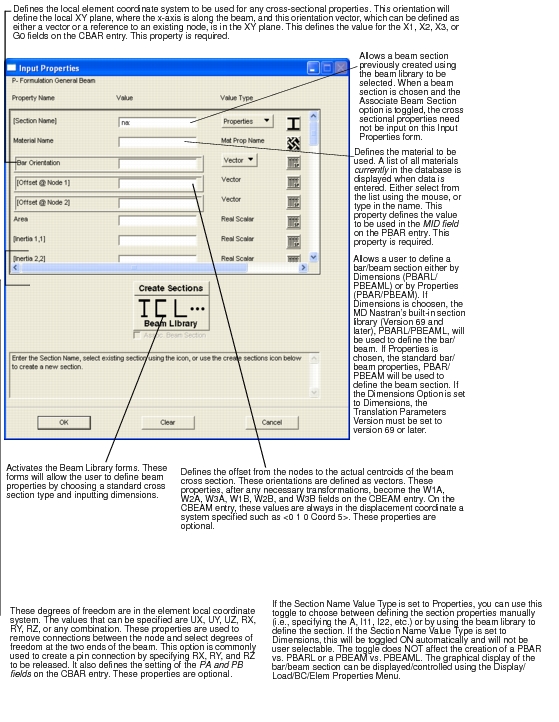
Prop Name | Description |
Area | Defines the cross-sectional area of the element. This is the A field on the PBEAM entry. This value can be either real values or a reference to an existing field definition. This property is required. |
Inertia 1,1 Inertia 2,2 Inertia 2,1 | Defines the various area moments of inertia of the cross section. These are the I1, I2, and I12 fields on the PBEAM entry. These values can be either real values or references to existing field definitions. These values are optional. |
Torsional Constant | Defines the torsional stiffness of the beam. This is the J field on the PBEAM entry. This value can be either a real value or a reference to an existing field definition. This property is optional. |
Shear Stiff, Y Shear Stiff, Z | Defines the shear stiffness values. These are the K1 and K2 fields on the PBEAM entry. These values can be either real values or references to existing field definitions. This property is optional. |
Nonstructural Mass | Defines mass not included in the mass derived from the material of the element. This is defined in terms of mass per unit length of the beam. This is the NSM field on the PBEAM entry. This value can be either a real value or reference to an existing field definition. This property is optional. |
Y of Point C Z of Point C X of Point D Y of Point D X of Point E Y of Point E X of Point F Y of Point F | Indicates the stress recovery. Define the Y and Z coordinates of the stress recovery points across the section of the beam as defined in the local element coordinate system. These are the C1, C2, D1, D2, E1, E2, F1, and F2 fields on the PBEAM entry. These values can be either real values or references to existing field definitions. These properties are optional. |
Station Distances | Defines up to 6 points along each bar element. Values specified are fractions of the beam length. Therefore, these values are in the range of 0. to 1. This defines the X1 and X6 fields on the CBARAO entry. The SCALE field on the CBARAO entry is always set to FR. The alternate format for the CBARAO records is not supported. These values are real values. These properties are optional. |
Starting P-orders and Maximum P-orders | Polynomial orders for displacement representation within elements. Each contains a list of three integers referring to the directions defined by the P-order Coordinate System (default elemental). Starting P-orders apply to the first adaptive cycle. The adaptive analysis process will limit the polynomial orders to the values specified in Maximum P-orders. These are the Polyi fields on the PVAL entry. |
P-order Coord. System | The two sets of three integer p-orders above refer to the axes of this coordinate system. By default, this system is elemental. This is the CID field on the PVAL entry. |
Activate Error Estimate | Flag controlling whether this set of elements participates in the error analysis. This is the ERREST field in the ADAPT entry. |
P-order Adaptivity | Controls the particular type of p-order adjustment from adaptive cycle to cycle. This is the TYPE field on the ADAPT entry. |
Error Tolerance | The tolerance used to determine if the adaptive analysis is complete. By default, equal to 0.1. This is the ERRTOL field on the ADAPT entry. |
Action | Dimension | Type | Option(s) | Topologies |
Create | 1D | Beam | Curved w/General Section | Bar/2 |
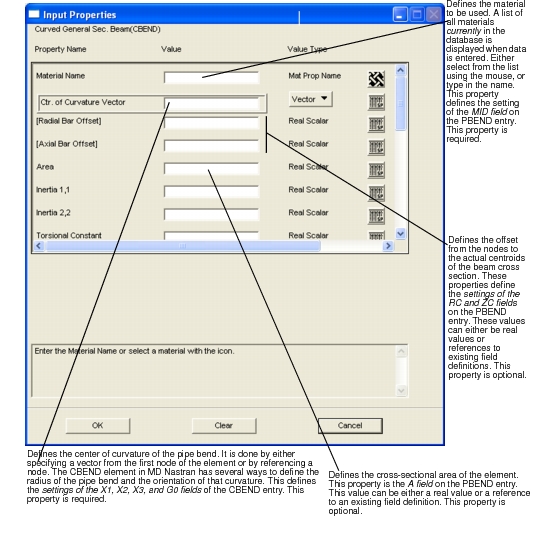
Prop Name | Description |
Inertia 1,1 Inertia 2,2 | Defines the various area moments of inertia of the cross section. These properties are the I1 and I2 fields on the PBEND entry. These values can either be real values or references to existing field definitions. These values are optional. |
Torsional Constant | Defines the torsional stiffness of the beam. This is the J field on the PBEND entry. This value can be either a real value, or a reference to an existing field definition. This property is optional. |
Shear Stiff, R Shear Stiff, Z | Defines the shear stiffness values. These properties are the K1 and K2 fields on the PBEND entry. These values can be either real values or references to existing field definitions. This property is optional. |
Nonstructural Mass | Defines mass not included in the mass derived from the material of the element. This property is defined in terms of mass per unit length of the beam and is the NSM field on the PBEND entry. This value can be either real value or a reference to an existing field definition. This property is optional. |
Radial NA Offset | Defines the radial offset of the geometric centroid from the end nodes. Positive values move the centroid of the section towards the center of curvature of the pipe bend. This property is the DELTAN field on the PBEND entry. This value can be either a real value or a reference to an existing field definition. This property is optional. |
R of Point C Z of Point C R of Point D Z of Point D R of Point E Z of Point E R of Point F Z of Point F | These properties are for stress recovery. They define the R and Z coordinates of the stress recovery points across the section of the beam, as defined in the local element coordinate system. These properties are the C1, C2, D1, D2, E1, E2, F1 and F2 fields on the PBEND entry. These values can be either real values or references to existing field definitions. These properties are optional. |
Action | Dimension | Type | Option(s) | Topologies |
Create | 1D | Beam | Curved W/Pipe Section | Bar/2 |
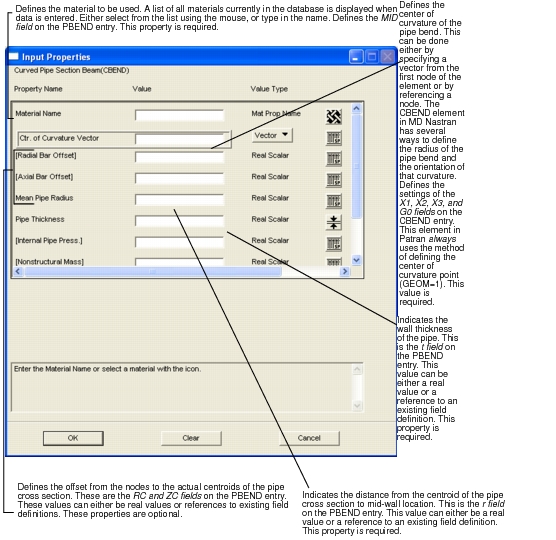
Prop Name | Description |
Internal Pipe Pressure | Indicates the static pressure inside the pipe elbow. This is the P field on the PBEND entry. This value can be either a real value or a reference to an existing field definition. This property is optional. |
Nonstructural Mass | Defines mass not included in the mass derived from the material of the element. This property is defined in terms of mass per unit length of the beam and is the NSM field on the PBEND entry. This value can either be a real value or a reference to an existing field definition. This property is optional. |
Stress Intensification | Indicates the desired type of stress intensification to be used. This is a character string value. This property is the FSI field on the PBEND entry. Valid settings of this parameter are General, ASME, and Welding Council. |
Action | Dimension | Type | Option(s) | Topologies |
Create | 1D | Beam | Lumped Section | Bar/2 |
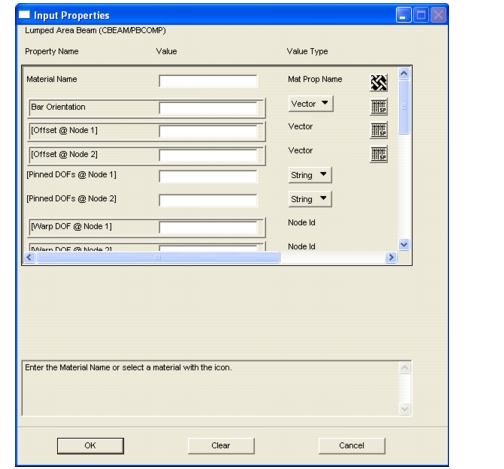
Note: | Patran will check the element associativity to other elements sharing this property set and will not export user defined pin unless the user includes an asterisk (*) in the string, in which case Patran will export the defined pin flags for all elements in the property set. |
Section Name | Specifies a beam section previously created using the beam library |
• Value Type | Allows you to define a bar/beam section either by Dimensions (PBARL/PBEAML) or by Properties (PBAR/PBEAM). If Dimensions is choosen, the MD Nastran’s built-in section library (Version 69 and later), PBARL/PBEAML, will be used to define the bar/beam. If Properties is chosen, the standard bar/beam properties, PBAR/PBEAM will be used to define the beam section. If the Dimensions Option is set to Dimensions, the Translation Parameters Version must be set to version 69 or later. |
Material Name | Defines the material to be used. A list of all materials currently in the database is displayed when data is entered. Either select from the list using the mouse, or type in the name. This defines the setting of the MID field on the PBCOMP entry. This property is required. |
Bar Orientation | Defines the local element coordinate system to be used for any cross-sectional properties. This orientation will define the local XY plane, where the x-axis is along the beam. This orientation defines the value for the X1, X2, X3, or G0 fields on the CBAR entry. This property is required. |
• Value Type | The orientation vector can be defined as either a vector or a reference to an existing node in the XY plane. |
• Reference Coordinates | Analysis - Analysis Coordinate System. Coord 0 - Basic Coordinate System. |
Offset @ Node 1 Offset @ Node 2 | Defines the offset from the nodes to the actual centroids of the beam cross section. These orientations are defined as vectors. These properties, after any necessary transformations, become the W1A, W2A, W3A, W1B, W2B, and W3B fields on the CBEAM entry. On the CBEAM entry, these values are always in the displacement coordinate system of the node. In Patran, they are either global, or in a system specified such as <0 1 0 Coord 5>. These properties are optional. |
• Value Type | Specifies that the offset is defined in terms of a vector. |
• Reference Coordinates | Analysis - Analysis Coordinate System. Element - Element Coordinate System. |
Pinned DOFs @ Node 1 Pinned DOFs @ Node 2 | Indicates whether certain degrees of freedom are to be released. By default, all degrees of freedom can transfer forces at the ends of beams. By releasing specified degrees of freedom, pin or sliding type connections can be created. These degrees-of-freedom are in the element local coordinate system. The values that can be specified here are UX, UY, UZ, RX, RY, RZ, or a combination. These properties define the settings of the PA and PB fields on the CBEAM entry and are optional. Note that if pinned DOF releases are defined within a property set, but the end nodes of the beams are connected to beams of a different property set, then no pinned DOFs will be written for those beams (PA or PB will be left blank). To override this and force the pin flags to be written per the property set, use an "*" after the specification for the DOFs. (This may be problematic if the property sets defined different pin DOFs.) For example, if rotation about the 2nd DOF is to be freed, specify "RY*." These values must be typed into the data box. Although there is a pull down menu next to the data box showing the valid selections, you will have to type the values in if more than one DOF or the "*" is to be specified. Specifying the "*" by itself does nothing. |
Warp DOF @ Node 1 Warp DOF @ Node 2 | Defines a node ID where the warping degree-of-freedom constraints and results will be placed. These must reference existing nodes within the model. They are the SA and SB fields on the CBEAM entry. These properties are optional. |
Area | Defines the cross-sectional area of the element. This is the A field on the PBCOMP entry. This value can be either a real value or a reference to an existing field definition. This property is optional. |
Nonstructural Mass | Defines mass not included in the mass derived from the material of the element. This is defined in terms of mass per unit length of the beam. This is the NSM field on the PBCOMP record. This value can be either a real value or a reference to an existing field definition. This property is optional. |
Shear Stiff, Y Shear Stiff, Z | Defines the shear stiffness values. These are the K1 and K2 fields on the PBCOMP entry. This value can be either a real value or a reference to an existing field definition. This property is optional. |
Y of NSM Z of NSM | Defines the offset from the centroid of the cross section to the location of the nonstructural mass. These values are measured in the beam cross-section coordinate system. These properties are the M1 and M2 fields on the PBCOMP entry. These values can be either real values or references to existing field definitions. These properties are optional. |
Symmetry Option | Specifies which type of symmetry is being used to define the lumped areas of the beam cross section. This is a character string parameter. The valid settings are No Symmetry, YZ Symmetry, Y Symmetry, Z Symmetry, or Y=Z Symmetry. This defines the setting of the SECTION field on the PBCOMP entry. This property is optional. |
Ys of Lumped Areas Zs of Lumped Areas | Defines the locations of the various lumped areas. These are defined in the cross-sectional coordinate system. These properties define the Yi and Zi fields on the PBCOMP entry. These values are lists of real values. These properties are optional. |
Area Factors | Defines the Fraction of the total area to be included in this lumped area. The sum of all area factors for a given section must equal 1.0. If the data provided does not meet this requirement, the values will all be scaled to the corrected value. These properties define the values for the Ci fields on the PBCOMP entry. These values are lists of real values. These properties are optional. |
Action | Dimension | Type | Option(s) | Topologies |
Create | 1D | Beam | Tapered | Bar/2 |
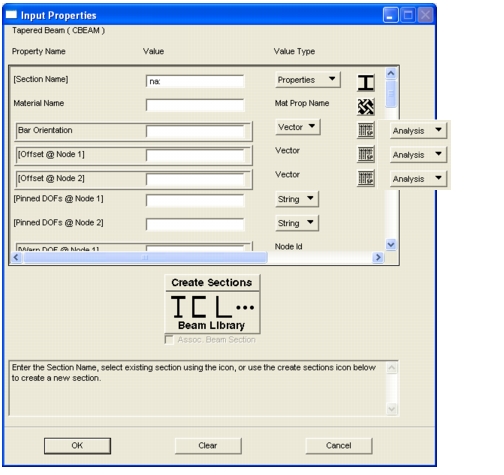
Note: | Patran will check the element associativity to other elements sharing this property set and will not export user defined pin unless the user includes an asterisk (*) in the string, in which case Patran will export the defined pin flags for all elements in the property set. |
Section Name | Specifies a beam section previously created using the beam library |
• Value Type | Allows you to define a bar/beam section either by Dimensions (PBARL/PBEAML) or by Properties (PBAR/PBEAM). If Dimensions is choosen, the MSC.Nastran’s built-in section library (Version 69 and later), PBARL/PBEAML, will be used to define the bar/beam. If Properties is chosen, the standard bar/beam properties, PBAR/PBEAM will be used to define the beam section. If the Dimensions Option is set to Dimensions, the Translation Parameters Version must be set to version 69 or later. |
Material Name | Defines the material to be used. A list of all materials currently in the database is displayed when data is entered. Either select from the list using the mouse, or type in the name. This defines the setting of the MID field on the PBCOMP entry. This property is required. |
Bar Orientation | Defines the local element coordinate system to be used for any cross-sectional properties. This orientation will define the local XY plane, where the x-axis is along the beam. This orientation, after any necessary transformations, defines the value for the X1, X2, X3, or G0 fields on the CBEAM entry. This property is required. |
• Value Type | Specifies how the bar orientation is defined: Vector – Specified using a vector Node Id – Specified using an existing node in the beam XY plane When the value type is Vector, it is always input in either the Patran global or some other Patran user defined coordinate system (i.e. <0 1 0 Coord 5>). |
• Reference Coordinates | Specifies the MD Nastran coordinate system in which the bar orientation vector will be written to the CBEAM entry: Analysis - Displacement Coordinate System at GA Coord 0 - Basic Coordinate System If Analysis is specified, a G will be written to the first position of the OFFT value on the CBEAM entry. If Coord 0 is specified, a B will be written. Note: The reference coordinate system specified does not affect how the input is interpreted within Patran. Only how it is written to the CBEAM entry. |
Offset @ Node 1 Offset @ Node 2 | Defines the offset from the nodes to the shear centers of the beam cross section. These orientations are defined as vectors. These properties, after any necessary transformations, become the W1A, W2A, W3A, W1B, W2B, and W3B fields on the CBEAM entry. These properties are optional. |
• Value Type | Specifies how the bar orientation is defined: Vector – Specified using a vector This is the only method available. The Reference Coordinate System controls how the vector input is interpreted in Patran. |
• Reference Coordinates | Specifies the MD Nastran coordinate system in which the offset vectors will be written to the CBEAM entry and how the vector input will be interpreted in Patran: Analysis - Displacement Coordinate Systems at GA and GB Element - Element Coordinate System If Analysis is specified, a G will be written to the second or third position of the OFFT value on the CBEAM entry. Within Patran, the vector will be interpreted to be in either the Patran global or some other Patran user defined coordinate system (i.e. <0 1 0 Coord 5>). If Element is specified, an E will be written to the second or third position of the OFFT value on the CBEAM entry. Within Patran, the vector will be interpreted to be in the Element coordinate system. |
Pinned DOFs @ Node 1 Pinned DOFs @ Node 2 | Indicates whether certain degrees of freedom are to be released. By default, all degrees of freedom can transfer forces at the ends of beams. By releasing specified degrees of freedom, pin or sliding type connections can be created. These degrees-of-freedom are in the element local coordinate system. The values that can be specified here are UX, UY, UZ, RX, RY, RZ, or a combination. These properties define the settings of the PA and PB fields on the CBEAM entry and are optional. Note that if pinned DOF releases are defined within a property set, but the end nodes of the beams are connected to beams of a different property set, then no pinned DOFs will be written for those beams (PA or PB will be left blank). To override this and force the pin flags to be written per the property set, use an "*" after the specification for the DOFs. (This may be problematic if the property sets defined different pin DOFs.) For example, if rotation about the 2nd DOF is to be freed, specify "RY*." These values must be typed into the data box. Although there is a pull down menu next to the data box showing the valid selections, you will have to type the values in if more than one DOF or the "*" is to be specified. Specifying the "*" by itself does nothing. |
Warp DOF @ Node 1 Warp DOF @ Node 2 | Defines a node ID where the warping degree of freedom constraints and results will be placed. These must reference existing nodes within the model. These are the SA and SB fields on the CBEAM entry. These properties are optional. |
Station Distances | Defines stations along each beam element where the section properties will be defined. The values specified here are fractions of the beam length. These values, therefore, are in the range of 0. to 1. These values define the settings of the X/XB fields on the PBEAM record. These values are real values. These properties are optional. |
Cross-Sect. Areas | Defines the cross-sectional area of the element. This property defines the settings of the A fields on the PBEAM record. This value can be either a real value, or reference to an existing field definition. This property is required. |
Inertias 1,1 Inertias 2,2 Inertias 1,2 | Defines the various area moments of inertia of the cross section. These defines the settings of the I1, I2, and I12 fields on the PBEAM entry. These values are real values. These properties are optional. |
Torsional Constants | Defines the torsional stiffness parameters. This property defines the J fields on the PBEAM entry. This is a list of real values, one for each station location. This property is optional. |
Ys of C Points Zs of C Points Ys of D points Zs of D Points Ys of E Points Zs of E Points Ys of F Points Zs of F Points | Defines the Y and Z locations in element coordinates, relative to the shear center for stress data recovery. These define the C1, C2, D1, D2, E1, E2, F1, and F2 fields on the PBEAM entry. These are lists of real values, one for each station location. These properties are optional. |
Nonstructural Masses | Defines the mass not included in the mass derived from the material of the element. This is defined in terms of mass per unit length of the beam. This property is the NSM field on the PBEAM entry. This is a list of real values, one for each station location. This property is optional. |
NSM Inertia @ Node 1 NSM Inertia @ Node 2 | Specified the nonstructural mass moments of inertia per unit length about the nonstructural mass center of gravity at each end of the element. These properties are the NSI(A) and NSI(B) fields on the PBEAM entry. These values can be either real values or references to existing field definitions. These properties are optional. |
Y of NSM @ Node 1 Z of NSM @ Node 1 Y of NSM @ Node 2 Z of NSM @ Node 2 | Defines the offset from the centroid of the cross section to the location of the nonstructural mass. These values are measured in the beam cross-section coordinate system. These are the M1(A), M2(A), M1(B), and M2(B) fields on the PBEAM entry. These values can be either real values or references to existing field definitions. These properties are optional. |
Shear Stiff, Y Shear Stiff, Z | Defines the shear stiffness values. These properties are the K1 and K2 fields on the PBEAM entry. These values can be either real values or references to existing field definitions. These properties are optional. |
Shear Relief Y Shear Relief Z | Defines the shear relief coefficients due to taper. These are the S1 and S2 fields on the PBEAM entry. These values can either be real values or references to existing field definitions. These properties are optional. |
Warp Coeff. @ Node 1 Warp Coeff. @ Node 2 | Specifies the warping coefficient at each end of the element. These properties are the CW(A) and CW(B) fields on the PBEAM entry. These values can be either real values or references to existing field definitions. These properties are optional. |
Y of NA @ Node 1 Z of NA @ Node 1 Y of NA @ Node 2 Z of NA @ Node 2 | Defines the offset from the centroid of the cross section to the location of the neutral axis. These values are measured in the beam cross section coordinate system and are the N1(A), N2(A), N1(B), and N2(B) fields on the PBEAM entry. These values can be either real values or references to existing field definitions. These properties are optional. |
Action | Dimension | Type | Option(s) |
Create | 1D | Beam | General Section (CBEAM) |
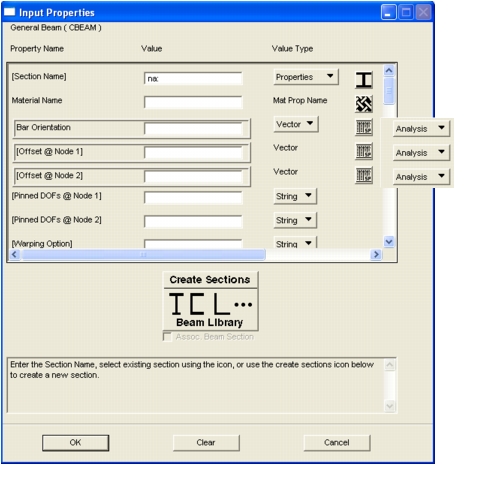
Note: | Patran will check the element associativity to other elements sharing this property set and will not export user defined pin flags for nodes which are shared by two beams sharing the same node. |
Section Name | Specifies a beam section previously created using the beam library |
• Value Type | Allows you to define a bar/beam section either by Dimensions (PBARL/PBEAML) or by Properties (PBAR/PBEAM). If Dimensions is choosen, the MSC.Nastran’s built-in section library (Version 69 and later), PBARL/PBEAML, will be used to define the bar/beam. If Properties is chosen, the standard bar/beam properties, PBAR/PBEAM will be used to define the beam section. If the Dimensions Option is set to Dimensions, the Translation Parameters Version must be set to version 69 or later. |
Material Name | Defines the material to be used. A list of all materials currently in the database is displayed when data is entered. Either select from the list using the mouse, or type in the name. This defines the setting of the MID field on the PBCOMP entry. This property is required. |
Bar Orientation | Defines the local element coordinate system to be used for any cross-sectional properties. This orientation will define the local XY plane, where the x-axis is along the beam. This orientation, after any necessary transformations, defines the value for the X1, X2, X3, or G0 fields on the CBEAM entry. This property is required. |
• Value Type | Specifies how the bar orientation is defined: Vector – Specified using a vector Node Id – Specified using an existing node in the beam XY plane When the value type is Vector, it is always input in either the Patran global or some other Patran user defined coordinate system (i.e. <0 1 0 Coord 5>). |
• Reference Coordinates | Specifies the MD Nastran coordinate system in which the bar orientation vector will be written to the CBEAM entry: Analysis - Displacement Coordinate System at GA Coord 0 - Basic Coordinate System If Analysis is specified, a G will be written to the first position of the OFFT value on the CBEAM entry. If Coord 0 is specified, a B will be written. Note: The reference coordinate system specified does not affect how the input is interpreted within Patran. Only how it is written to the CBEAM entry. |
Offset @ Node 1 Offset @ Node 2 | Defines the offset from the nodes to the shear centers of the beam cross section. These orientations are defined as vectors. These properties, after any necessary transformations, become the W1A, W2A, W3A, W1B, W2B, and W3B fields on the CBEAM entry. These properties are optional. |
• Value Type | Specifies how the bar orientation is defined: Vector – Specified using a vector This is the only method available. The Reference Coordinate System controls how the vector input is interpreted in Patran. |
• Reference Coordinates | Specifies the MD Nastran coordinate system in which the offset vectors will be written to the CBEAM entry and how the vector input will be interpreted in Patran: Analysis - Displacement Coordinate Systems at GA and GB Element - Element Coordinate System If Analysis is specified, a G will be written to the second or third position of the OFFT value on the CBEAM entry. Within Patran, the vector will be interpreted to be in either the Patran global or some other Patran user defined coordinate system (i.e. <0 1 0 Coord 5>). If Element is specified, an E will be written to the second or third position of the OFFT value on the CBEAM entry. Within Patran, the vector will be interpreted to be in the Element coordinate system. |
Pinned DOFs @ Node 1 Pinned DOFs @ Node 2 | Indicates whether certain degrees of freedom are to be released. By default, all degrees of freedom can transfer forces at the ends of beams. Pin or sliding type connections can be created by releasing specified degrees of freedom. These degrees of freedom are in the element local coordinate system. The values specified here are UX, UY, UZ, RX, RY, RZ, or a combination. These properties define the settings of the PA and PB fields on the CBEAM entry. These properties are optional. Note that if pinned DOF releases are defined within a property set, but the end nodes of the beams are connected to beams of a different property set, then no pinned DOFs will be written for those beams (PA or PB will be left blank). To override this and force the pin flags to be written per the property set, use an "*" after the specification for the DOFs. (This may be problematic if the property sets defined different pin DOFs.) For example, if rotation about the 2nd DOF is to be freed, specify "RY*." These values must be typed into the data box. Although there is a pull down menu next to the data box showing the valid selections, you will have to type the values in if more than one DOF or the "*" is to be specified. Specifying the "*" by itself does nothing. |
Warping Option | This specifies how contraints should be applied to the warping SPOINTs of unmatched ends within the application region (see continuity rules above). The choices available include “A free B free”, “A fixed B fixed”, “A free B fixed”, “A fixed B free”, or “None”. The choice of “None” is used to disable warping altogether for the current element property set, in which case no SPOINTs will be generated or constrained. Only unmatched ends within the application region will be eligible for constraining, and whether or not a constraint is applied will depend on the option selected, and whether the unmatched end is “End A” or “End B” of its beam element. If no selection is made for this element property, “A free B free” is selected by default. |
Warp Coeff. @ Node 1 Warp Coeff. @ Node 2 | Specifies the warping coefficient at each end of the element. These properties are the CW(A) and CW(B) fields on the PBEAM entry. These values can be either real values or references to existing field definitions. These properties are optional. |
Station Distances | Defines stations along each beam element where the section properties will be defined. The values specified here are fractions of the beam length. These values, therefore, are in the range of 0. to 1. These values define the settings of the X/XB fields on the PBEAM record. This field consists of a set of real values separated by legal delimiters, such as white space and/or commas. If this list is entered, then the properties that follow may also be in the form of lists consisting of the same number of values. If they are in the form of a single real value, then that value will apply to all stations of the beam element. This property is optional. If it is not provided, then all other specified section properties apply to the entire beam, and lists of values will not be accepted. |
Cross-Sect. Areas | Defines the cross sectional area of the element. This property defines the settings of the A fields on the PBEAM record. This value can be either a real value, a list (if a list of stations has been provided), or a reference to an existing field definition, in which case a single real value will be evaluated for each element of the application region. This property is required. |
Inertias 1,1 Inertias 2,2 Inertias 1,2 | Defines the various area moments of inertia of the cross section. These values define the settings of the I1, I2, and I12 fields on the PBEAM entry. These values are single real values that apply to the entire beam, or a list of real values if a list of stations has been provided. These properties are optional. If they are not provided, values of 0 will be assumed. |
Torsional Constants | Defines the torsional stiffness parameters. This property defines the J fields on the PBEAM entry. This value is a single real value that applies to the entire beam, or a list of real values if a list of stations has been provided. This property is optional. If it is not provided, a value of 0 will be assumed. |
Ys of C Points Zs of C Points Ys of D Points Zs of D Points Ys of E Points Zs of E Points Ys of F Points Zs of F Points | Defines the Y and Z locations in element coordinates, relative to the shear center, for stress data recovery. These define the C1, C2, D1, D2, E1, E2, F1, and F2 fields on the PBEAM entry. These values are single real values that apply to the entire beam, or lists of real values if a list of stations has been provided. These properties are optional. If they are not provided, values of 0 will be assumed. |
Nonstructural Masses | Defines the mass not included in the mass derived from the material of the element. This is defined in terms of mass per unit length of the beam. This property is the NSM field on the PBEAM entry. This value is a single real value that applies to the entire beam, or a list of real values if a list of stations has been provided. This property is optional. If it is not provided, a value of 0 will be assumed. |
NSM Inertia @ Node 1 NSM Inertia @ Node 2 | Specifies the nonstructural mass moments of inertia per unit length about the nonstructural mass center of gravity at each end of the element. These properties are the NSI(A) and NSI(B) fields on the PBEAM entry. These values can be either real values or references to existing field definitions. These properties are optional. |
Y of NSM @ Node 1 Z of NSM @ Node 1 Y of NSM @ Node 2 Z of NSM @ Node 2 | Defines the offset from the shear center of the cross section to the location of the nonstructural mass. These values are measured in the beam cross-section coordinate system. These are the M1(A), M2(A), M1(B), and M2(B) fields on the PBEAM entry. These values can be either real values or references to existing field definitions. These properties are optional. |
Shear Stiff, Y Shear Stiff, Z | Defines the shear stiffness values. These properties are the K1 and K2 fields on the PBEAM entry. These values can be either real values or references to existing field definitions. These properties are optional. |
Shear Relief Y Shear Relief Z | Defines the shear relief coefficients due to taper. These are the S1 and S2 fields on the PBEAM entry. These values can either be real values or references to existing field definitions. These properties are optional. |
Y of NA @ Node 1 Z of NA @ Node 1 Y of NA @ Node 2 Z of NA @ Node 2 | Defines the offset from the shear center of the cross section to the location of the neutral axis. These values are measured in the beam cross-section coordinate system. These are the N1(A), N2(A), N1(B), and N2(B) fields on the PBEAM entry. These values can be either real values or references to existing field definitions. These properties are optional. |
Action | Dimension | Type | Option(s) | Topologies |
Create | 1D | Rod | General Section Standard | Bar/2 |
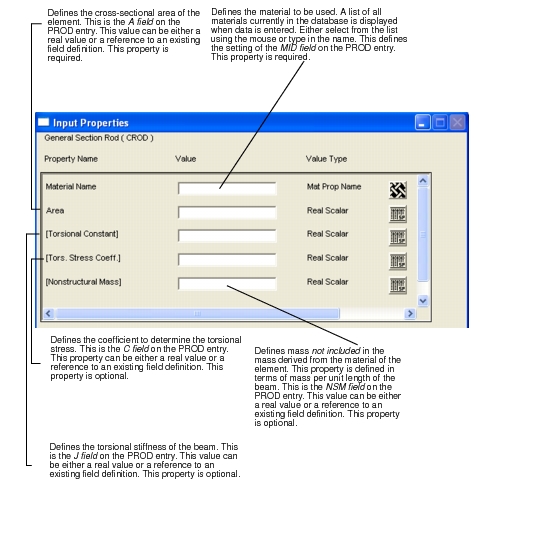
Action | Dimension | Type | Option(s) | Topologies |
Create | 1D | Rod | General Section CONROD | Bar/2 |
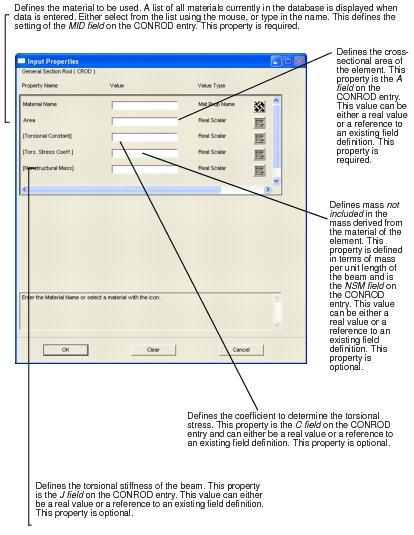
Action | Dimension | Type | Option(s) | Topologies |
Create | 1D | Rod | Pipe Section | Bar/2 |
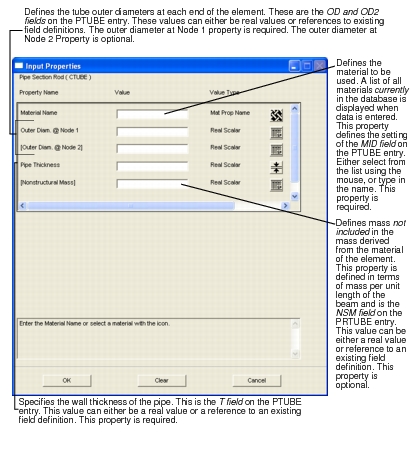
Action | Dimension | Type | Option(s) | Topologies |
Create | 1D | Spring | Bar/2 |
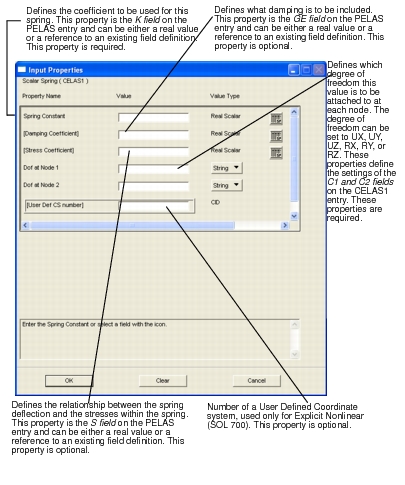
Action | Dimension | Type | Option(s) | Topologies |
Create | 1D | Damper | Scalar | Bar/2 |
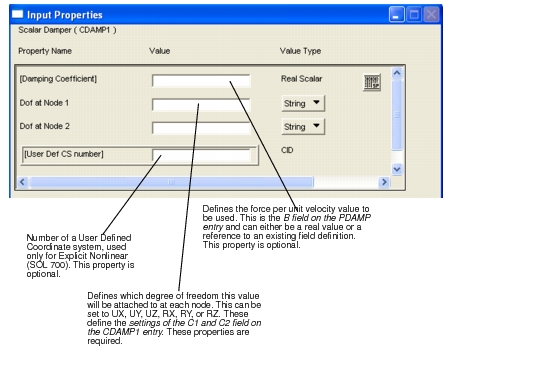
Action | Dimension | Type | Option(s) | Topologies |
Create | 1D | Damper | Viscous | Bar/2 |
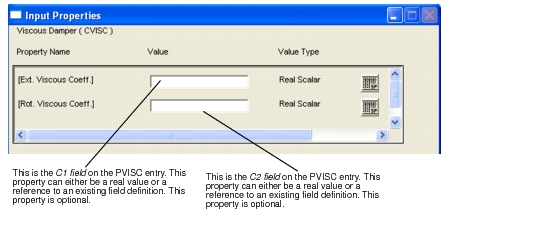
Action | Dimension | Type | Option(s) | Topologies |
Create | 1D | Gap | Adaptive Nonadaptive | Bar/2 |
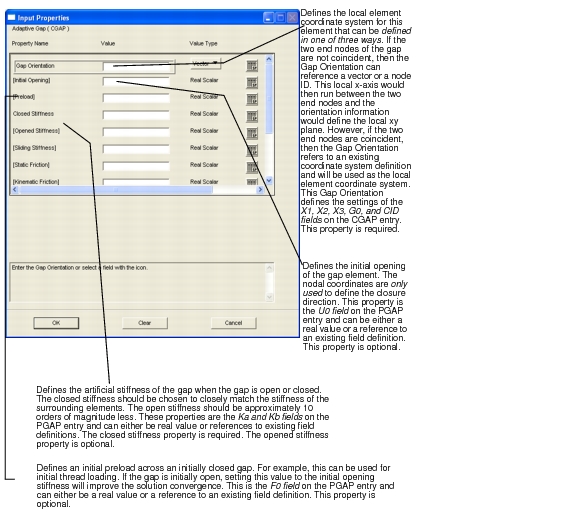
Prop Name | Description |
Sliding Stiffness | Defines the artificial shear stiffness of the element when the element is closed. This is the Kt field on the PGAP entry. This property can be either a real value or a reference to an existing field definition. This property is optional. |
Static Friction | Defines the static friction coefficient. This property is the MU1 field on the PGAP entry. This value is optional and can be a real scalar or a spatially varying real scalar field. |
Kinematic Friction | Defines the kinematic friction coefficient. This property is the MU2 field on the PGAP entry. This value is optional and can be a real scalar or a spatially varying real scalar field. |
Max Penetration | Defines the maximum allowable penetration. This property is the TMAX field on the PGAP entry. This value is optional and can be a real scalar or a spatially varying real scalar field. |
Max Adjust Ratio | Defines the maximum allowable adjustment ratio. This property is the MAR field on the PGAP entry. This value is optional and can be a real scalar or a spatially varying real scalar field. |
Penet. Lower Bound | Defines the lower bound for the allowable penetration. This is the TRMIN field on the PGAP entry. This value is optional and can be a real scalar or a spatially varying real scalar field. |
Friction Coeff. y Friction Coeff. Z | Defines the coefficient of friction when sliding occurs along this element in the local y and z directions. These are the MU1 and MU2 fields on the PGAP entry and can be either real values or references to existing field definitions. These properties are optional. |
Action | Dimension | Type | Option(s) | Topologies |
Create | 1D | 1D Mass | Bar/2 |
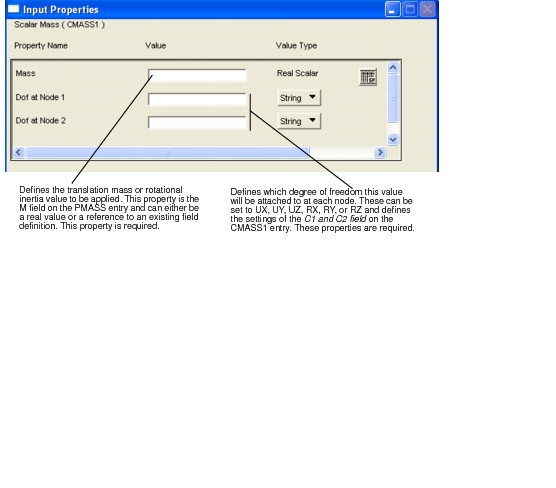
Action | Dimension | Type | Option(s) | Topologies |
Create | 1D | PLOTEL | Bar/2 |
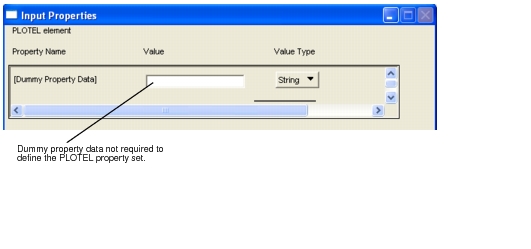
Action | Dimension | Type | Option(s) | Topologies |
Create | 1D | Bush | Bar/2 |
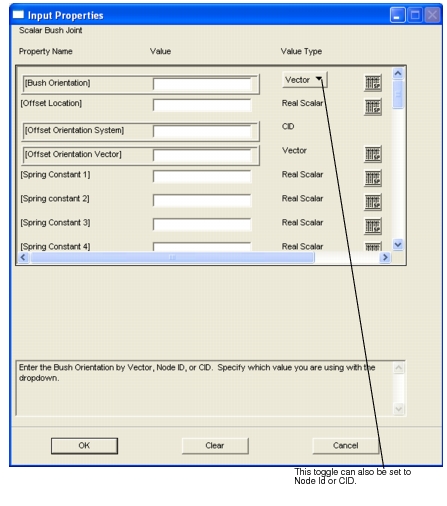
Prop Name | Description |
Bush Orientation | Element orientation strategy keys off of CID specification. If CID is blank, the element x-axis lies along the line which joins the elements grid points (GA, GB Element Properties/Application Region). The X-Y plane is determined by specifying the Bush Orientation. If a vector input is given, these components define an orientation vector If a CID ≥ 0 is specified for Bush Orientation System, the element X,Y, and Z axes are aligned with the coordinate system principal axes. If the CID is for a cylindrical or spherical coordinate system, the first elemental grid point (GA) is used to locate the system. If CID = 0, the elemental coordinate system is the Basic Coordinate System. If no orientation is specified in any form, the element x-axis is along the line which connects the element’s grid points. The material property inputs for this condition must be limited to simple axial and torsional stiffness and damping (k1,k4,B1,B4). |
Offset Location | Offset Location (0.0 ≤ s ≤ 1.0) specifies the spring-damper location along the line from GRIDGA to GRIDGB by setting the fraction of the distance from GRIDGA. s=0.50 centers the spring-damper. |
Offset Orientation System | Specifies the coordinate system used to locate the spring-damper offset when it is not on the line from GRIDGA to GRIDGB. |
Offset Orientation Vector | Provides the location of the spring-damper in space relative to the offset coordinate system. If the offset orientation system is -1 or blank, the offset orientation vector is ignored. |
Spring Constant 1 Spring Constant 2 Spring Constant 3 Spring Constant 4 Spring Constant 5 Spring Constant 6 Stiff. Freq Depend 1 Stiff. Freq Depend 2 Stiff. Freq Depend 3 Stiff. Freq Depend 4 Stiff. Freq Depend 5 Stiff. Freq Depend 6 | Defines the stiffness associated with a particular degree of freedom. This property is defined in terms of force per unit displacement and can be either a real value or a reference to an existing field definition for defining stiffness vs. frequency. |
Stiff. Force/Disp 1 Stiff. Force/Disp 2 Stiff. Force/Disp 3 Stiff. Force/Disp 4 Stiff. Force/Disp 5 Stiff. Force/Disp 6 | Defines the nonlinear force/displacement curves for each degree of freedom of the spring-damper system. |
Damping Coefficient 1 Damping Coefficient 2 Damping Coefficient 3 Damping Coefficient 4 Damping Coefficient 5 Damping Coefficient 6 Damp. Freq Depend 1 Damp. Freq Depend 2 Damp. Freq Depend 3 Damp. Freq Depend 4 Damp. Freq Depend 5 Damp. Freq Depend 6 | Defines the force per velocity damping value for each degree of freedom. This property can be either a real value or a reference to an existing field definition for defining damping vs. frequency |
Structural Damping Struc. Damp Freq Depend | Defines the non-dimensional structural damping coefficient (GE1). This property can be either a real value, or a reference to an existing field definition for defining damping vs. frequency. |
Stress Recovery Translation Stress Recovery Rotation | Stress Recovery Coefficients. The element stress are computed by multiplying the stress coefficients with the recovered element forces. |
Strain Recovery Translation Strain Recovery Rotation | Strain Recovery Coefficients. The element strains are computed by multiplying the strain coefficients with the recovered element strains. |
Action | Dimension | Type | Option(s) | Topologies |
Create | 1D | Spot Weld Connector | Connector |
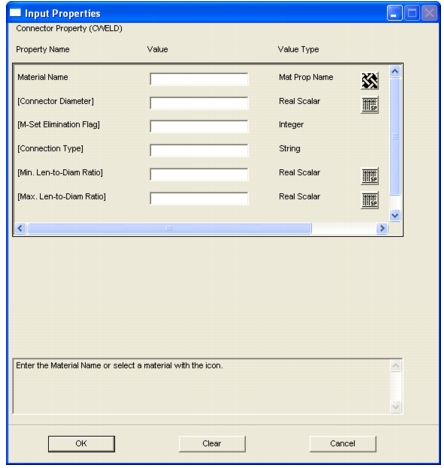
Action | Dimension | Type | Option(s) | Topologies |
Create | 1D | Fastener Connector | Connector |
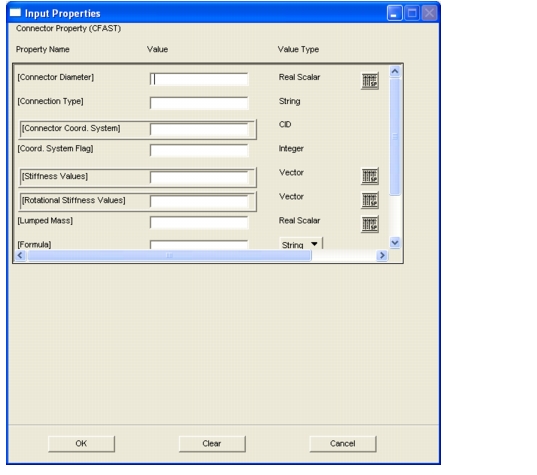



a | b | |
Hi-Lok in CFRP | 0.6667 | 4.2 |
Hi-Lok in metal | 0.6667 | 3.0 |
Solid Rivet | 0.4 | 2.2 |
Symbol | Meaning |
Ef | Young’s modulus of fastener |
df | Diameter of fastener |
l | Length of fastener, evaluated from the FE model |
E1 | Young’s modulus of first property connected to the fastener |
t1 | Thickness of first property connected to the fastener |
E2 | Young’s modulus of second property connected to the fastener |
t2 | Thickness of second property connected to the fastener |
Action | Dimension | Type | Option(s) | Topologies |
Create | 2D | Shell | Homogeneous Standard Formulation | Tri/3, Quad/4 Tri/6, Quad/8 |
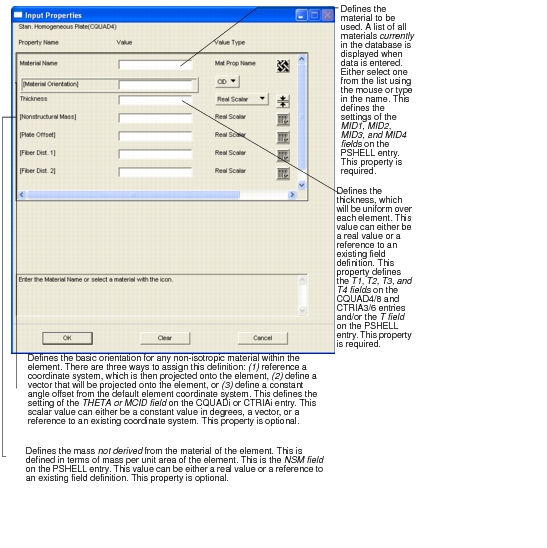
Prop Name | Description |
Plate Offset | Defines the offset of the element’s reference plane from the plane defined by the nodal locations. This is the ZOFFS field on the CQUAD4/8 entry and can be either a real value or a reference to an existing field definition. This property is optional. |
Fiber Dist. 1 Fiber Dist. 2 | Defines the distance from the element’s reference plane to the bottom and top most extreme fibers, respectively. These properties define the Z1 and Z2 fields on the PSHELL entry and can be either real values or references to existing field definitions. This property is optional. |
Nonlinear Formulation | This optional property word can take on any of the three values Automatic, Large Strain, or Small Strain and is only recognized for implicit nonlinear (SOL 400) analyses. Automatic is the default if not specified and determines if large or small strain is appropriate based on the existence of an elastoplastic material constitutive model and/or if the elements are contained in a contact body. If appropriate, the PSHLN1/2 entry is written for this property set. Large Strain forces the PSHLN1/2 entry to be written, regardless; and Small Strain forces it not to be written, regardless. In addition, if large strain is forced or detected, the usage of NLMOPTS, LRGSTRN,0 or 1 is written based on the setting on the Load Increment Parameters form when defining a Subcase. See Static Subcase Parameters for Implicit Nonlinear Solution Type, 369. |
Action | Dimension | Type | Option(s) | Topologies |
Create | 2D | Shell | Homogeneous Revised Formulation | Tri/3, Quad/4 |
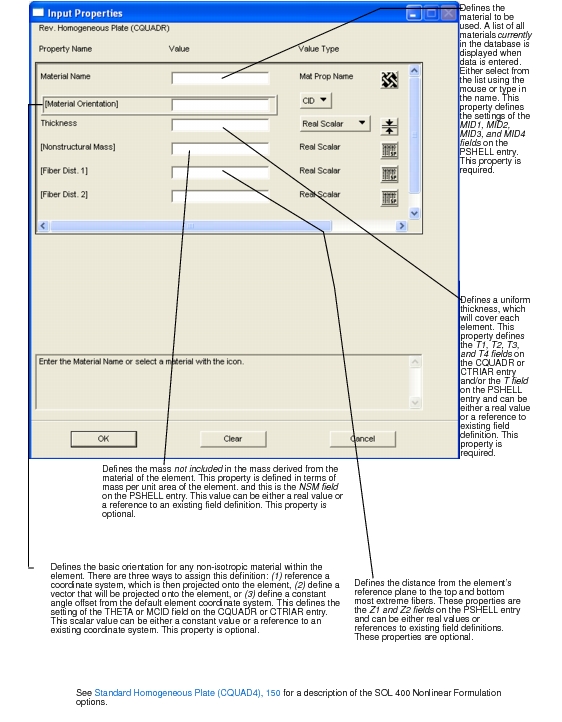
Action | Dimension | Type | Option(s) | Topologies |
Create | 2D | Shell | Homogeneous P-Formulation | Tri/3, Quad/4,Tri/6, Quad/8, Tri/7, Quad/9, Tri/9, Quad/12, Tri/13, Quad/16 |
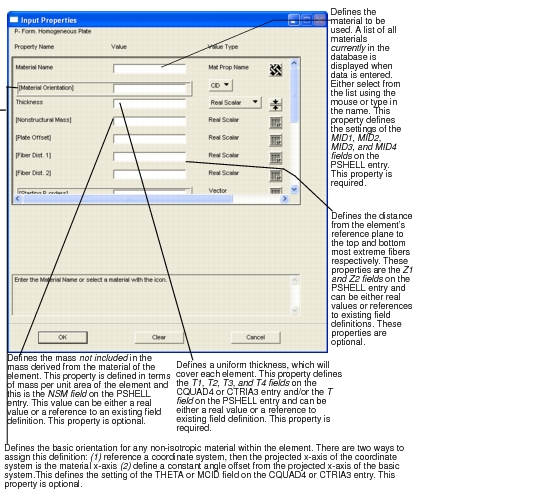
Prop Name | Description |
Plate Offset | Defines the offset of the element’s reference plane from the plane defined by the nodal locations. This is the ZOFFS field on the CQUAD4 or CTRIA3 entry and can be either a real value or a reference to an existing field definition. This property is optional. |
Fiber Dist. 1 Fiber Dist. 2 | Defines the distance from the element’s reference plane to the top and bottom most extreme fibers, respectively. These properties define the Z1 and Z2 fields on the PSHELL entry and can be either real values or references to existing field definitions. This property is optional. |
Starting P-orders and Maximum P-orders | Polynomial orders for displacement representation within elements. Each contains a list of three integers referring to the directions defined by the P-‑order Coordinate System (default elemental). Starting P-orders apply to the first adaptive cycle. The adaptive analysis process will limit the polynomial orders to the values specified in Maximum P-orders. These are the Polyi fields on the PVAL entry. |
P-order Coord. System | The three sets of three integer p-orders above refer to the axes of this coordinate system. By default, this system is elemental. This is the CID field on the PVAL entry. |
Activate Error Estimate | Flag that controls whether or not this set of elements participates in the error analysis. This is the ERREST field on the ADAPT entry. |
P-order Adaptivity | Controls the particular type of p-order adjustment from adaptive cycle to cycle. This is the TYPE field on the ADAPT entry. |
Error Tolerance | The tolerance used to determine if the adaptive analysis is complete. By default this value is equal to 0.1. This is the ERRTOL field on the ADAPT entry. |
Stress Threshold Value | Elements with von Mises stress below this value will not participate in the error analysis. By default this value is equal to 0.0. This is the SIGTOL field on the ADAPT entry. |
Strain Threshold Value | Elements with von Mises strain below this value will not participate in the error analysis.By default this value is equal to1.0E-8. This is the EPSTOL field on the ADAPT entry. |
Action | Dimension | Type | Option(s) | Topologies |
Create | 2D | Shell | Laminate Standard Formulation | Tri/3, Quad/4 Tri/6, Quad/8 |
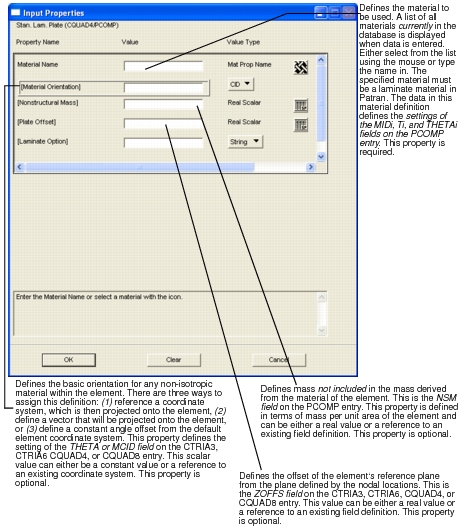
Prop Name | Description |
Laminate Options | Laminate option placed on the LAM field of the PCOMP/PCOMPG entry. No option implies all plies must be specified and all stiffness terms developed. MEM - all plies are specified but only membrane terms are computed. BEND - all plies specified but only bending terms computed. SMEAR - all plies specified, stacking sequence ignored and TS/T and 12I/T**3 terms set to zero. SMCORE - all plies specified with the last ply specifying core properties and the previous plies specifying face sheet properties. See the Nastran Quick Reference Guide for more details. |
Nonlinear Formulation | This optional property word can take on any of the three values Automatic, Large Strain, or Small Strain and is only recognized for implicit nonlinear (SOL 400) analyses. Automatic is the default if not specified and determines if large or small strain is appropriate based on the existence of an elastoplastic material constitutive model and/or if the elements are contained in a contact body. If appropriate, the PSHLN1/2 entry is written for this property set. Large Strain forces the PSHLN1/2 entry to be written, regardless; and Small Strain forces it not to be written, regardless. In addition, if large strain is forced or detected, the usage of NLMOPTS, LRGSTRN,0 or 1 is written based on the setting on the Load Increment Parameters form when defining a Subcase. See Static Subcase Parameters for Implicit Nonlinear Solution Type, 369. |
Note: | TREF is written to PCOMP from the value defined on the first MAT8 entry defined in the composite, or in other words, from the material of the first ply in the layup. The value of GE is written to PCOMP as the sum of all GE values on all plies, scaled based on the percentage thickness of each ply. To get values for TREF and GE from the PCOMP entry, the 2D/Shell/Thin/Laminate/Standard and Revised formulations need to have property words used to define these values. If the values are not defined then the values are retrieved from the MAT8 material card. |
Action | Dimension | Type | Option(s) | Topologies |
Create | 2D | Shell | Laminate Revised Formulation | Tri/3, Quad/4 |
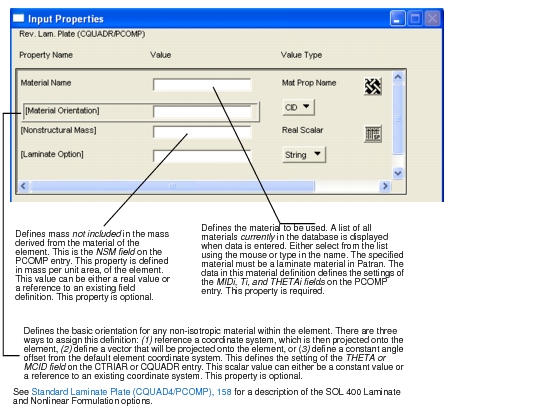
Note: | TREF is written to PCOMP from the value defined on the first MAT8 entry defined in the composite, or in other words, from the material of the first ply in the layup. The value of GE is written to PCOMP as the sum of all GE values on all plies, scaled based on the percentage thickness of each ply. To get values for TREF and GE from the PCOMP entry, the 2D/Shell/Thin/Laminate/Standard and Revised formulations need to have property words used to define these values. If the values are not defined then the values are retrieved from the MAT8 material card. |
Action | Dimension | Type | Option(s) | Topologies |
Create | 2D | Shell | Equivalent Section Standard Formulation | Tri/3, Quad/4 Tri/6, Quad/8 |
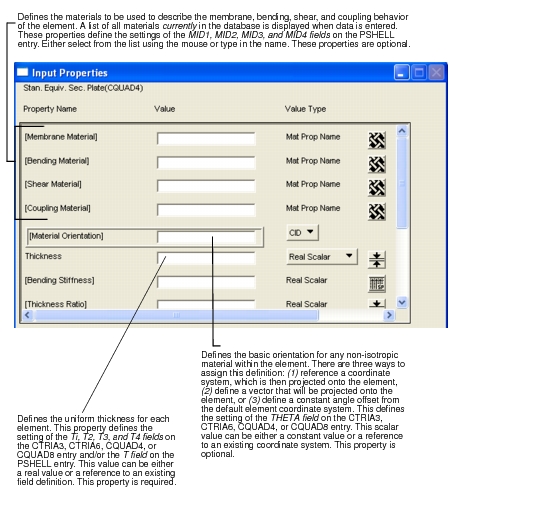
Prop Name | Description |
Bending Stiffness | Defines the bending stiffness parameter. This is the 12I/T3 field on the PSHELL entry. This value can be either a real value or a reference to an existing field definition. This property is optional. |
Thickness Ratio | Defines the ratio of transverse shear thickness to the membrane thickness. This property is the TS/T field on the PSHELL entry. This value can be either a real value or a reference to an existing field definition. This property is optional. |
Nonstructural Mass | Defines mass not included in the mass derived from the material of the element. This is defined in terms of mass per unit area of the element. This property is the NSM field on the PSHELL entry. This value can be either a real value or a reference to an existing field definition. This property is optional. |
Plate Offset | Defines the offset of the element’s reference plane from the plane defined by the nodal locations. This property is the ZOFFS field on the CTRIA3, CTRIA6, CQUAD4, or CQUAD8 entry. This value can be either a real value or a reference to an existing field definition. This property is optional. |
Fiber Distance 1 Fiber Distance 2 | Defines the distance from the element’s reference plane to the top and bottom most extreme fibers, respectively. These properties are the Z1 and Z2 fields on the PSHELL entry. These values can be either real values or references to existing field definitions. These properties are optional. |
Nonlinear Formulation | This optional property word can take on any of the three values Automatic, Large Strain, or Small Strain and is only recognized for implicit nonlinear (SOL 400) analyses. Automatic is the default if not specified and determines if large or small strain is appropriate based on the existence of an elastoplastic material constitutive model and/or if the elements are contained in a contact body. If appropriate, the PSHLN1/2 entry is written for this property set. Large Strain forces the PSHLN1/2 entry to be written, regardless; and Small Strain forces it not to be written, regardless. In addition, if large strain is forced or detected, the usage of NLMOPTS, LRGSTRN,0 or 1 is written based on the setting on the Load Increment Parameters form when defining a Subcase. See Static Subcase Parameters for Implicit Nonlinear Solution Type, 369. |
Action | Dimension | Type | Option(s) | Topologies |
Create | 2D | Shell | Equivalent Section Revised Formulation | Tri/3, Quad/4 |
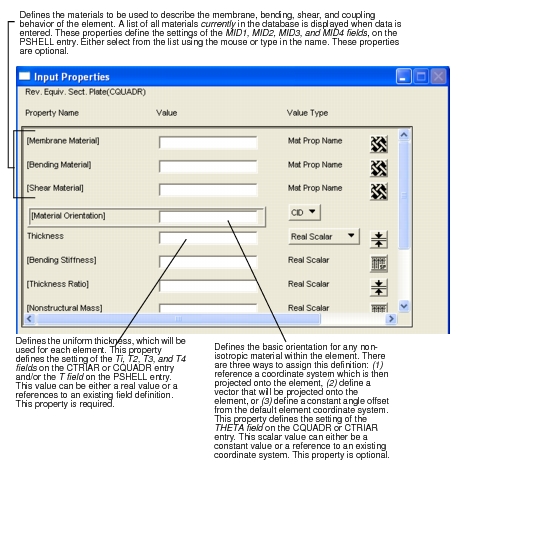
Prop Name | Description |
Bending Stiffness | Defines the bending stiffness parameter. This property is the 12I/T3 field on the PSHELL entry. This value can be either a real value or a reference to an existing field definition. This property is optional. |
Thickness Ratio | Defines the ratio of transverse shear thickness to the membrane thickness. This is the TS/T field on the PSHELL entry. This value can be either a real value or a reference to an existing field definition. This property is optional. |
Nonstructural Mass | Defines mass not included in the mass derived from the material of the element. This property is defined in terms of mass per unit area of the element. This is the NSM field on the PSHELL entry. This value can be either a real value or a reference to an existing field definition. This property is optional. |
Fiber Distance 1 Fiber Distance 2 | Defines the distance from the element’s reference plane to the top and bottom most extreme fibers respectively. These properties are the Z1 and Z2 fields on the PSHELL entry. These values can be either real values or references to existing field definitions. These properties are optional. |
Nonlinear Formulation | This optional property word can take on any of the three values Automatic, Large Strain, or Small Strain and is only recognized for implicit nonlinear (SOL 400) analyses. Automatic is the default if not specified and determines if large or small strain is appropriate based on the existence of an elastoplastic material constitutive model and/or if the elements are contained in a contact body. If appropriate, the PSHLN1/2 entry is written for this property set. Large Strain forces the PSHLN1/2 entry to be written, regardless; and Small Strain forces it not to be written, regardless. In addition, if large strain is forced or detected, the usage of NLMOPTS, LRGSTRN,0 or 1 is written based on the setting on the Load Increment Parameters form when defining a Subcase. See Static Subcase Parameters for Implicit Nonlinear Solution Type, 369. |
Action | Dimension | Type | Option(s) | Topologies |
Create | 2D | Shell | Equivalent Section P-Formulation | Tri/3, Quad/4, Tri/6, Quad/8, Tri/7, Quad/9, Tri/9, Quad/12, Tri/13, Quad/16 |
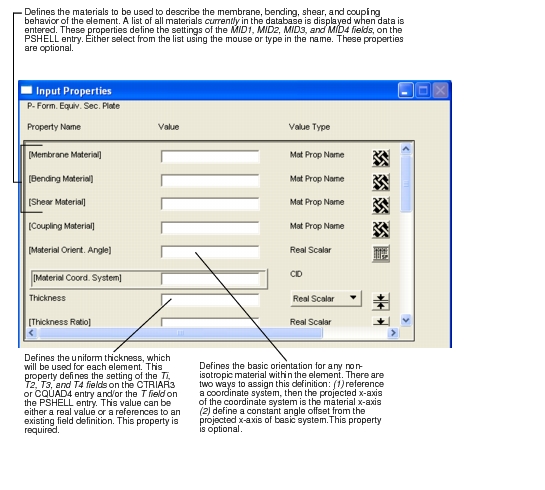
Prop Name | Description |
Bending Stiffness | Defines the bending stiffness parameter. This property is the 12I/T3 field on the PSHELL entry. This value can be either a real value or a reference to an existing field definition. This property is optional. |
Thickness Ratio | Defines the ratio of transverse shear thickness to the membrane thickness. This is the TS/T field on the PSHELL entry. This value can be either a real value or a reference to an existing field definition. This property is optional. |
Nonstructural Mass | Defines mass not included in the mass derived from the material of the element. This property is defined in terms of mass per unit area of the element. This is the NSM field on the PSHELL entry. This value can be either a real value or a reference to an existing field definition. This property is optional. |
Plate Offset | Defines the offset of the element’s reference plane from the plane defined by the nodal locations. This is the ZOFFS field on the CQUAD4 or CTRIA3entry and can be either real value or reference to an existing field definition. This property is optional. |
Fiber Dist. 1 Fiber Dist. 2 | Defines the distance from the element’s reference plane to the top and bottom most extreme fibers, respectively. These properties define the Z1 and Z2 fields on the PSHELL entry and can be either real value or references to existing field definitions. This property is optional. |
Starting P-orders and Maximum P-orders | Polynomial orders for displacement representation within elements. Each contains a list of three integers referring to the directions defined by the P-order Coordinate System (default elemental). Starting P-orders apply to the first adaptive cycle. The adaptive analysis process will limit the polynomial orders to the values specified in Maximum P-orders. These are the Polyi fields in the PVAL entry. |
P-order Coord. System | The three sets of three integer p-orders above refer to the axes of this coordinate system. By default, this system is elemental. This is the CID field on the PVAL entry. |
Activate Error Estimate | Flag controlling whether this set of elements participates in the error analysis. This is the ERREST field in the ADAPT entry. |
P-order Adaptivity | Controls the particular type of p-order adjustment from adaptive cycle to cycle. This is the TYPE field on the ADAPT entry. |
Error Tolerance | The tolerance used to determine if the adaptive analysis is complete. By default, equal to 0.1. This is the ERRTOL field on the ADAPT entry. |
Stress Threshold Value | Elements with von Mises stress below this value will not participate in the error analysis. By default, equal to 0.0. This is the SIGTOL field on the ADAPT entry. |
Strain Threshold Value | Elements with von Mises strain below this value will not participate in the error analysis. By default, equal to1.0E-8. This is the EPSTOL field on the ADAPT entry. |
Action | Dimension | Type | Option(s) | Topologies |
Create | 2D | Shell | Field Point Mesh | Tri/3, Quad/4 |
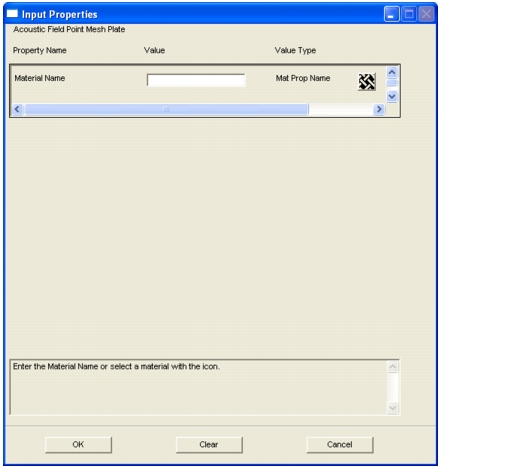
Action | Dimension | Type | Option(s) | Topologies |
Create | 2D | Bending Panel | Standard Formulation | Tri/3, Quad/4 Tri/6, Quad/8 |
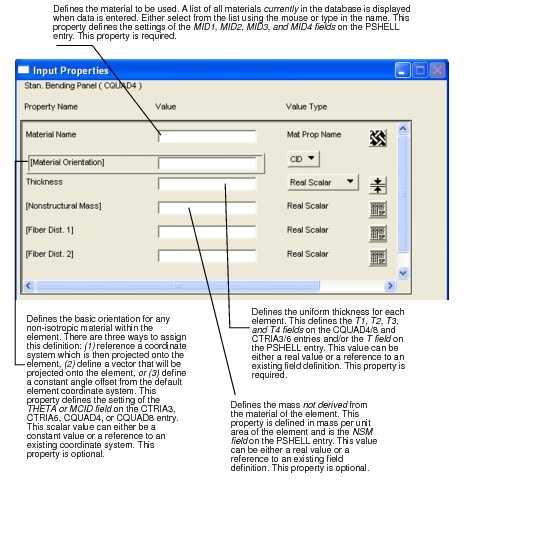
Prop Name | Description |
Fiber Dist. 1 Fiber Dist. 2 | Defines the distance from the element’s reference plane to the top and bottom most extreme fibers respectively. These properties define the Z1 and Z2 fields on the PSHELL entry and these values can be either real values or references to existing field definitions. These properties are optional. |
Action | Dimension | Type | Option(s) | Topologies |
Create | 2D | Bending Panel | Revised Formulation | Tri/3, Quad/4 |
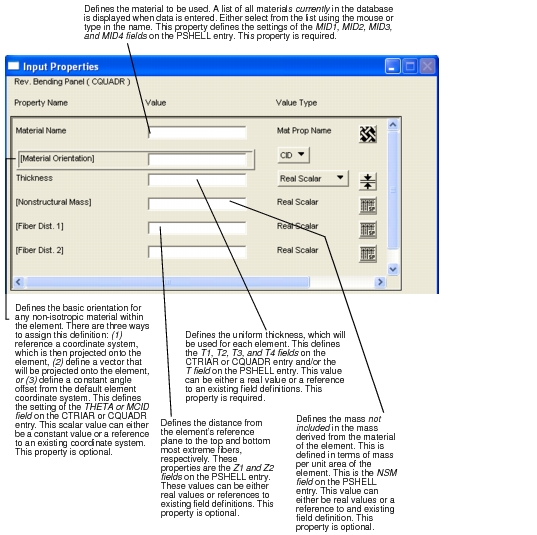
Action | Dimension | Type | Option(s) | Topologies |
Create | 2D | Bending Panel | P- Formulation | Tri/3, Quad/4, Tri/6, Quad/8, Tri/7, Quad/9, Tri/9, Quad/12, Tri/13, Quad/16 |
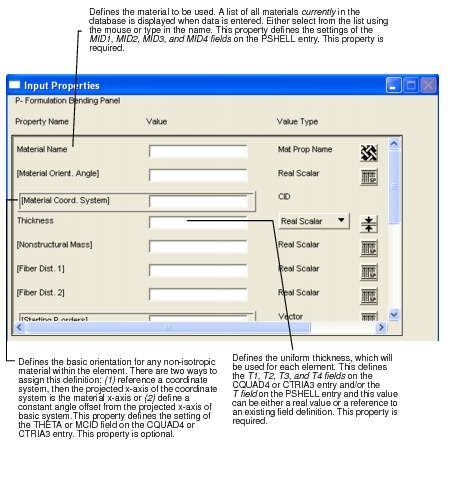
Prop Name | Description |
Nonstructural Mass | Defines mass not included in the mass derived from the material of the element. This property is defined in terms of mass per unit area of the element. This is the NSM field on the PSHELL entry. This value can be either a real value or a reference to an existing field definition. This property is optional. |
Fiber Dist. 1 Fiber Dist. 2 | Defines the distance from the element’s reference plane to the top and bottom most extreme fibers, respectively. These properties define the Z1 and Z2 fields on the PSHELL entry. These values can be either real values or references to existing field definitions. These properties are optional. |
Starting P-orders and Maximum P-orders | Polynomial orders for displacement representation within elements. Each contains a list of three integers referring to the directions defined by the P-order Coordinate System (default elemental). Starting P-orders apply to the first adaptive cycle. The adaptive analysis process will limit the polynomial orders to the values specified in Maximum P-orders. These are the Polyi fields on the PVAL entry. |
P-order Coord. System | The three sets of three integer p-orders above refer to the axes of this coordinate system. By default this system is elemental. This is the CID field on the PVAL entry. |
Activate Error Estimate | Flag controlling whether this set of elements participates in the error analysis. This is the ERREST field on the ADAPT entry. |
P-order Adaptivity | Controls the particular type of p-order adjustment from adaptive cycle to cycle. This is the TYPE field on the ADAPT entry. |
Error Tolerance | The tolerance used to determine if the adaptive analysis is complete. By default this value is equal to 0.1. This is the ERRTOL field on the ADAPT entry. |
Stress Threshold Value | Elements with von Mises stress below this value will not participate in the error analysis. By default this value is equal to 0.0. This is the SIGTOL field on the ADAPT entry. |
Strain Threshold Value | Elements with von Mises strain below this value will not participate in the error analysis. By default this value is equal to1.0E-8. This is the EPSTOL field on the ADAPT entry. |
Action | Dimension | Type | Option(s) | Topologies |
Create | 2D | 2D Solid | Axisymmetric | Tri/3, Tri/6 |
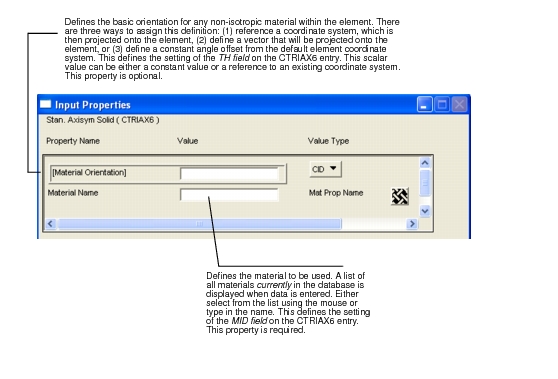
Action | Dimension | Type | Option 1 | Option 2 | Topologies |
Create | 2D | 2D Solid | Axisymmetric | Hyperelastic PLPLANE | Tri/3, Tri/6, QUAD/4, QUAD/8 |
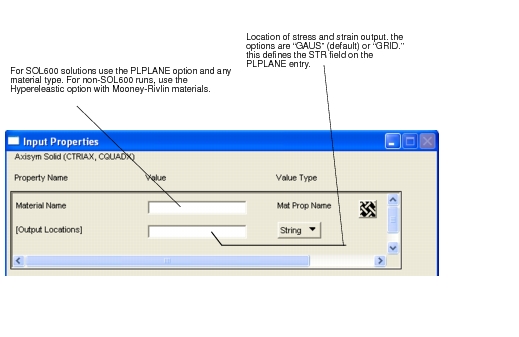
Action | Dimension | Type | Option(s) | Topologies |
Create | 2D | 2D Solid | Laminate | CQUADX |
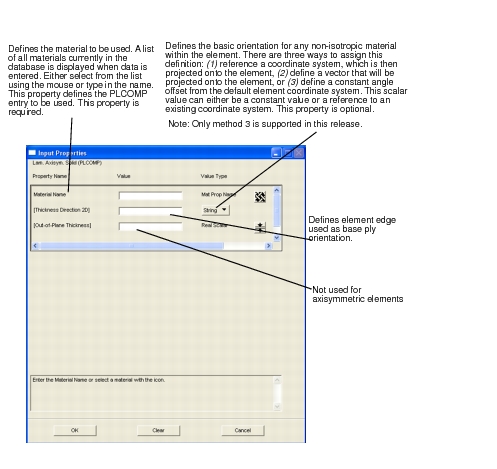
Action | Dimension | Type | Option(s) | Topologies |
Create | 2D | 2D Solid | Plane Strain Standard Formulation | Tri/3, Quad/4 Tri/6, Quad/8 |
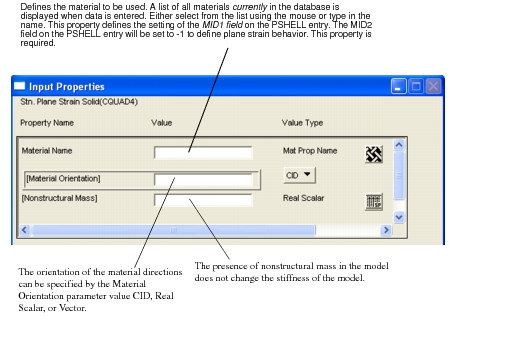
Action | Dimension | Type | Option(s) | Topologies |
Create | 2D | 2D Solid | Plane Strain Revised Formulation | Tri/3, Quad/4 |
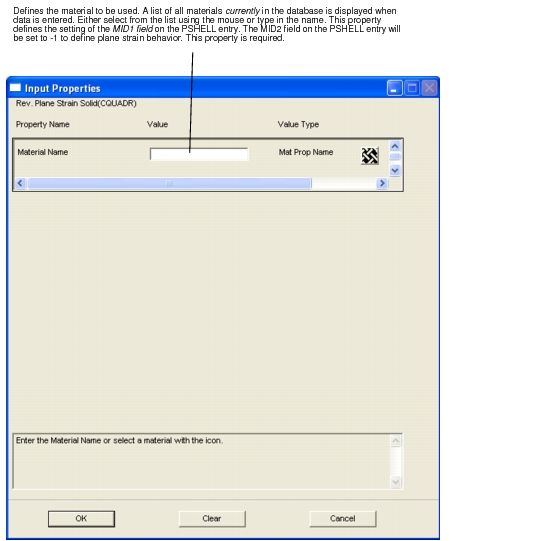
Action | Dimension | Type | Option(s) | Topologies |
Create | 2D | 2D Solid | Plane Strain P- Formulation | Tri/3, Quad/4, Tri/6, Quad/8, Tri/7, Quad/9, Tri/9, Quad/12, Tri/13, Quad/16 |
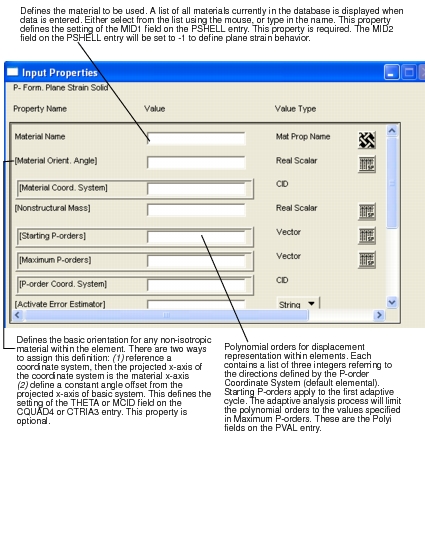
Prop Name | Description |
P-order Coord. System | The three sets of three integer p-orders above refer to the axes of this coordinate system. By default, this system is elemental. This is the CID field on the PVAL entry. |
Activate Error Estimate | Flag controlling whether this set of elements participates in the error analysis. This is the ERREST field on the ADAPT entry. |
P-order Adaptivity | Controls the particular type of p-order adjustment from adaptive cycle to cycle. This is the TYPE field on the ADAPT entry. |
Error Tolerance | The tolerance used to determine if the adaptive analysis is complete. By default this value is equal to 0.1. This is the ERRTOL field on the ADAPT entry. |
Stress Threshold Value | Elements with von Mises stress below this value will not participate in the error analysis. By default this value is equal to 0.0. This is the SIGTOL field on the ADAPT entry. |
Strain Threshold Value | Elements with von Mises strain below this value will not participate in the error analysis. By default this value is equal to 1.0E-8. This is the EPSTOL field on the ADAPT entry. |
Action | Dimension | Type | Option(s) | Topologies |
Create/Modify | 2D | 2D Solid | Tri/6, Quad/4, Quad/8 |
Action | Dimension | Type | Option(s) | Topologies |
Create | 2D | 2D Solid | Infinite | Tri/3, Quad/4 |
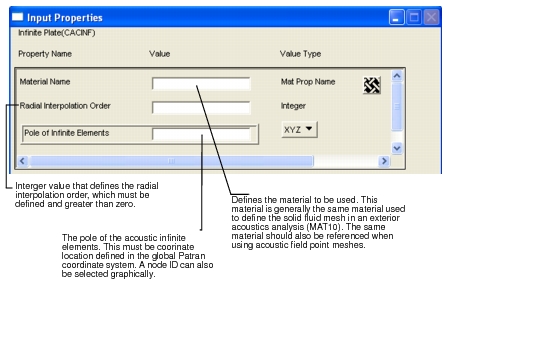
Action | Dimension | Type | Option(s) | Topologies |
Create | 2D | 2D Solid | Laminate | QUAD/4, QUAD/8 |
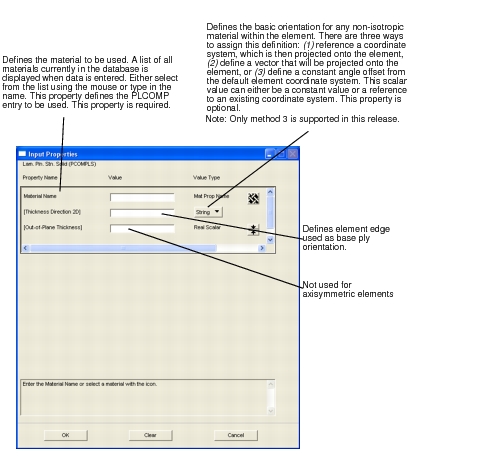
Action | Dimension | Type | Option(s) | Topologies |
Create | 2D | Membrane | Standard Formulation | Tri/3, Quad/4 Tri /6, Quad/8 |
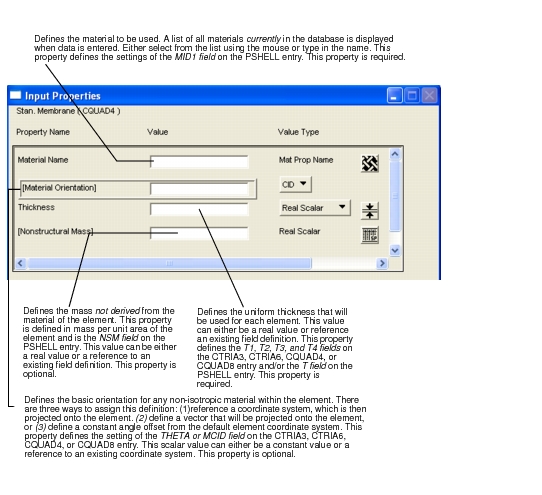
Action | Dimension | Type | Option(s) | Topologies |
Create | 2D | Membrane | Revised Formulation | Tri/3, Quad/4 |
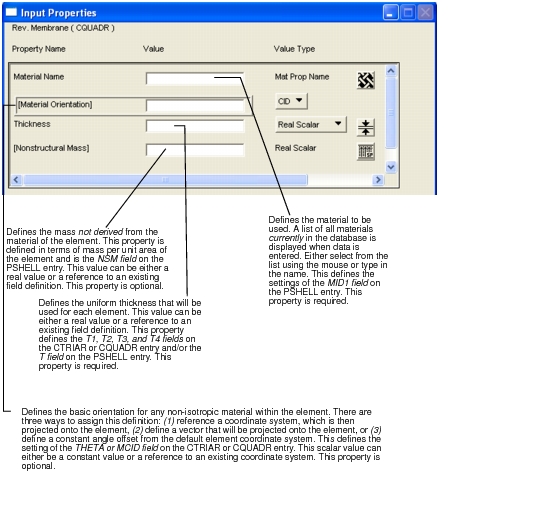
Action | Dimension | Type | Option(s) | Topologies |
Create | 2D | Membrane | P- Formulation | Tri/3, Quad/4, Tri/6, Quad/8, Tri/7, Quad/9. Tri/9, Quad/12, Tri/13, Quad/16 |
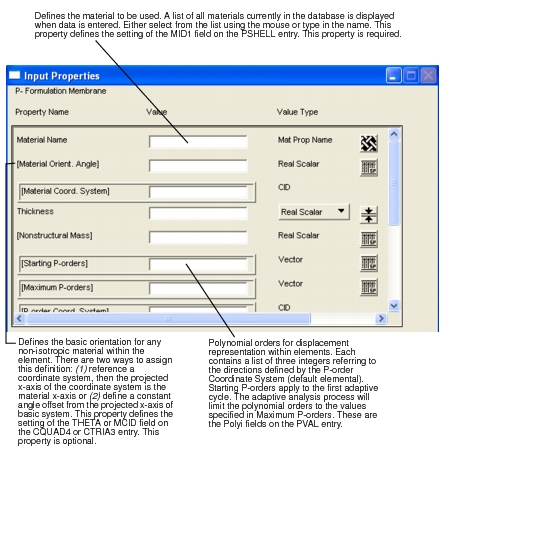
Prop Name | Description |
P-order Coord. System | The three sets of three integer p-orders above refer to the axes of this coordinate system. By default this system is elemental. This is the CID field on the PVAL entry. |
Activate Error Estimate | Flag controlling whether this set of elements participates in the error analysis. This is the ERREST field on the ADAPT entry. |
P-order Adaptivity | Controls the particular type of p-order adjustment from adaptive cycle to cycle. This is the TYPE field on the ADAPT entry. |
Error Tolerance | The tolerance used to determine if the adaptive analysis is complete. By default this value is equal to 0.1. This is the ERRTOL field on the ADAPT entry. |
Stress Threshold Value | Elements with von Mises stress below this value will not participate in the error analysis. By default this value is equal to 0.0. This is the SIGTOL field on the ADAPT entry. |
Strain Threshold Value | Elements with von Mises strain below this value will not participate in the error analysis. By default this value is equal to 1.0E-8. This is the EPSTOL field on the ADAPT entry. |
Action | Dimension | Type | Option(s) | Topologies |
Create | 2D | Shear Panel | Quad/4 |
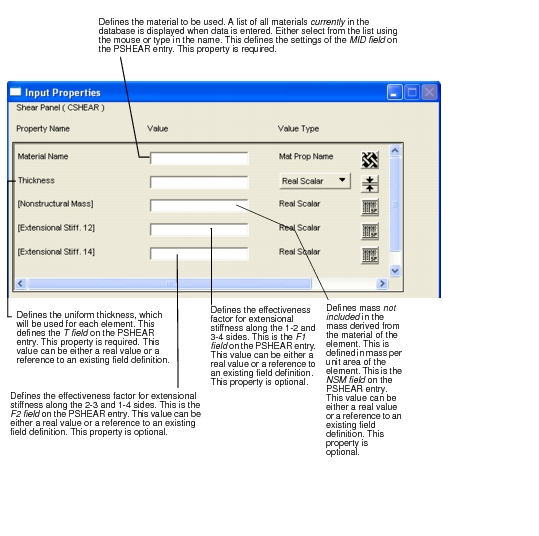
Nonlinear Formulation | This optional property word can take on any of the three values Automatic, Large Strain, or Small Strain and is only recognized for implicit nonlinear (SOL 400) analyses. Automatic is the default if not specified and determines if large or small strain is appropriate based on the existence of an elastoplastic material constitutive model and/or if the elements are contained in a contact body. If appropriate, the PSHEARN entry is written for this property set. Large Strain forces the PSHEARN entry to be written, regardless; and Small Strain forces it not to be written, regardless. In addition, if large strain is forced or detected, the usage of NLMOPTS, LRGSTRN,0 or 1 is written based on the setting on the Load Increment Parameters form when defining a Subcase. See Static Subcase Parameters for Implicit Nonlinear Solution Type, 369. |
Action | Dimension | Type | Option 1 | Option 2 | Topologies |
Create/ Modify | 3D | Solid | Homogeneous | Standard Formulation Solid Shell | Tet4/10, Wedge6/15 Hex8/20 |
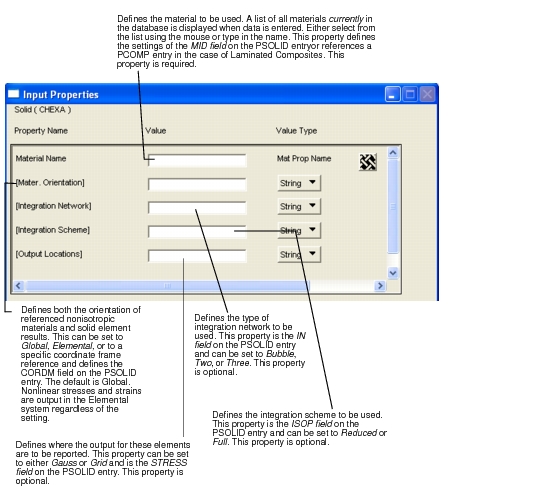
Nonlinear Formulation | This optional property word can take on any of the three values Automatic, Large Strain, or Small Strain and is only recognized for implicit nonlinear (SOL 400) analyses. Automatic is the default if not specified and determines if large or small strain is appropriate based on the existence of an elastoplastic material constitutive model and/or if the elements are contained in a contact body. If appropriate, the PSLDN1 entry is written for this property set. Large Strain forces the PSLDN1 entry to be written, regardless; and Small Strain forces it not to be written, regardless. In addition, if large strain is forced or detected, the usage of NLMOPTS, LRGSTRN,0 or 1 is written based on the setting on the Load Increment Parameters form when defining a Subcase. See Static Subcase Parameters for Implicit Nonlinear Solution Type, 369. |
Action | Dimension | Type | Option(s) | Topologies |
Create | 3D | Solid | P-Formulation | Tet/4, Wedge/6 Hex/8, Tet/10 Wedge/15, Hex/20, Tet/16, Tet/40, Wedge/24,Wedge/52, Hex/32, Hex/64 |
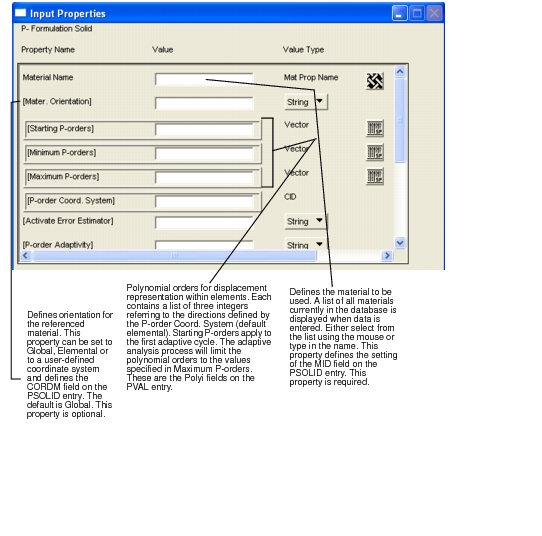
Prop Name | Description |
P-order Coord. System | The three sets of three integer p-orders above refer to the axes of this coordinate system. By default, this system is elemental. This is the CID field on the PVAL entry. |
Activate Error Estimate | Flag controlling whether this set of elements participates in the error analysis. This is the ERREST field on the ADAPT entry. |
P-order Adaptivity | Controls the particular type of p-order adjustment from adaptive cycle to cycle. This is the TYPE field on the ADAPT entry. |
Error Tolerance | The tolerance used to determine if the adaptive analysis is complete. By default the value is equal to 0.1. This is the ERRTOL field on the ADAPT entry. |
Stress Threshold Value | Elements with von Mises stress below this value will not participate in the error analysis. By default the value is equal to 0.0. This is the SIGTOL field on the ADAPT entry. |
Strain Threshold Value | Elements with von Mises strain below this value will not participate in the error analysis. By default the value is equal to 1.0E-8. This is the EPSTOL field on the ADAPT entry. |
Integration Network | Defines the type of integration network to be used. This property is the IN field on the PSOLID entry and can be set to Bubble, Two, or Three. This property is optional. |
Integration Scheme | Defines where the output for these elements are to be reported. This can be set to either Gauss or Grid. This property is the STRESS field on the PSOLID entry. This property is optional. |
Action | Dimension | Type | Option(s) | Topologies |
Create | 2D | 2D Solid | Plane Strain Hyperelastic Formulation | Tri/3, Quad/4, Tri/6, Quad/8, Quad/9 |
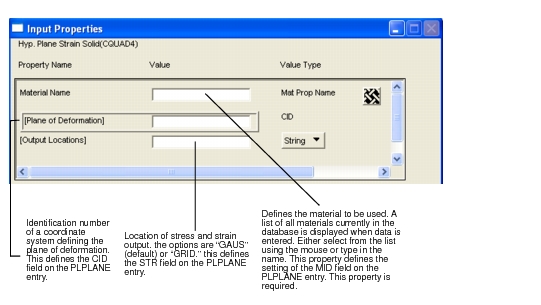
Action | Dimension | Type | Option(s) | Topologies |
Create | 2D | 2D Solid | Axisymmetric Hyperelastic Formulation | CQUADX, CTRIAX |
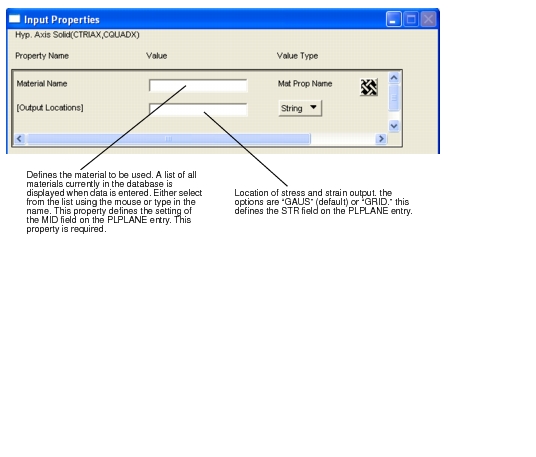
Action | Dimension | Type | Option(s) | Topologies |
Create | 3D | Solid | Hyperelastic Formulation | HEX, PENT, TET |
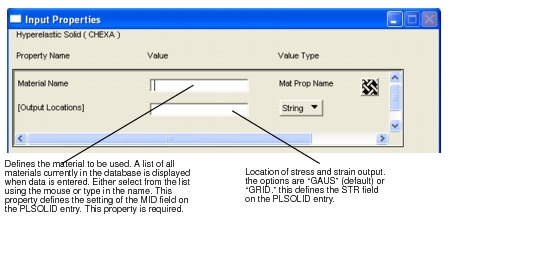
Nonlinear Formulation | This optional property word can take on any of the three values Automatic, Large Strain, or Small Strain and is only recognized for implicit nonlinear (SOL 400) analyses. Automatic is the default if not specified and determines if large or small strain is appropriate based on the existence of an elastoplastic material constitutive model and/or if the elements are contained in a contact body. If appropriate, the PSLDN1 entry is written for this property set. Large Strain forces the PSLDN1 entry to be written, regardless; and Small Strain forces it not to be written, regardless. In addition, if large strain is forced or detected, the usage of NLMOPTS, LRGSTRN,0 or 1 is written based on the setting on the Load Increment Parameters form when defining a Subcase. See Static Subcase Parameters for Implicit Nonlinear Solution Type, 369. |
Action | Dimension | Type | Option(s) | Topologies |
Create | 3D | Solid | Laminate | HEX, PENT, TET |
